-
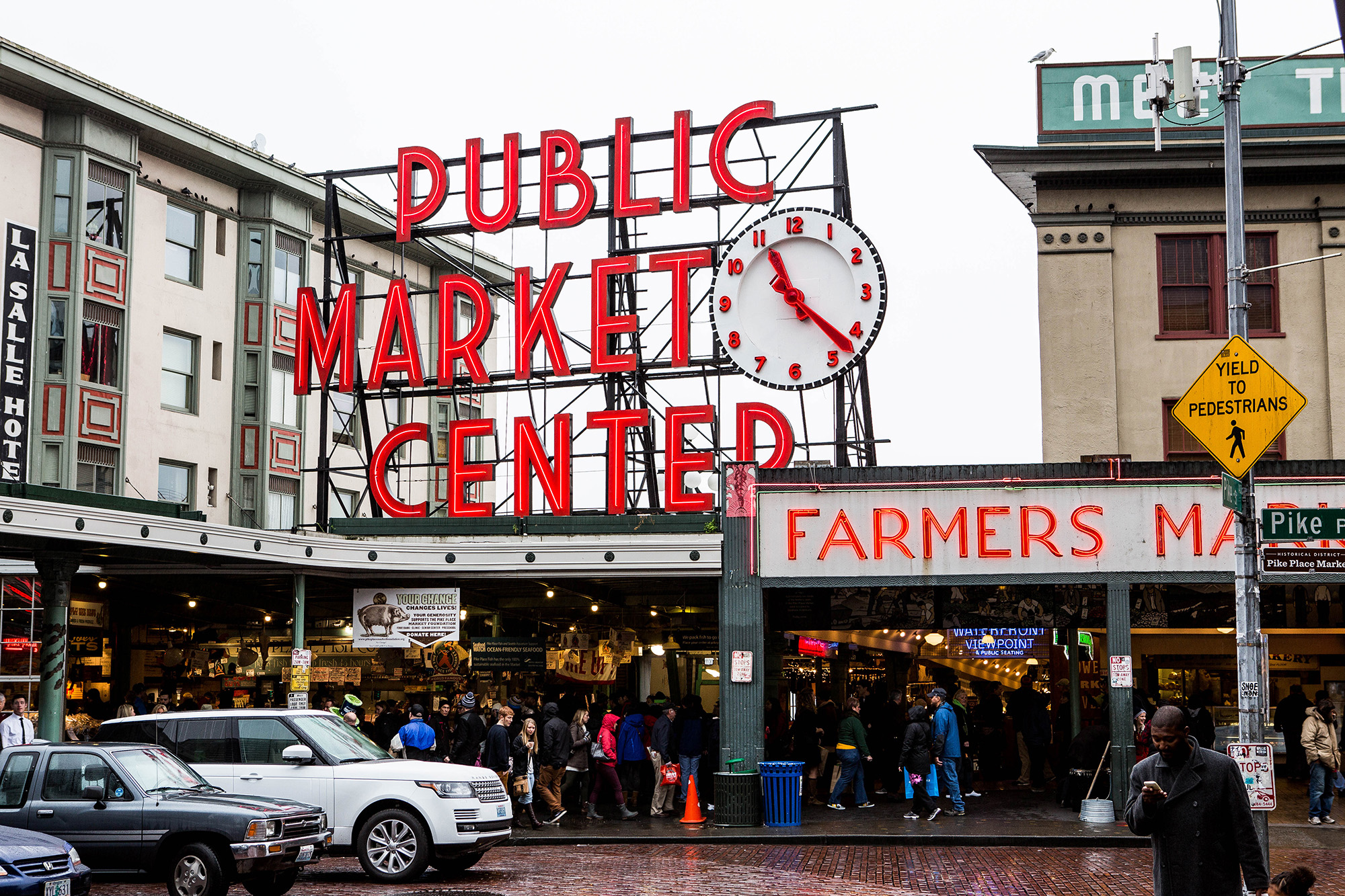 Pike Place Market
Pike Place Market 1987 Rudy Bruner Award for Urban Excellence - Gold Medal
Pike Place Market in Seattle renovated historic waterfront buildings to create a thriving farmers market with retail, low-income housing, and social services. Much more than a market, the project spans seven acres and includes 300 businesses and 750 subsidized housing units in an interdependent network of business owners, consumers, and neighbors.
The Market Foundation, created to support local residents, offers a wide a variety of social services including a health clinic, food bank, child care center, and senior center to strengthen and serve the community.
The farmers market was established in 1907 by local farmers in response to steep price increases in produce. The project preserves the founders’ commitment to creating and serving community by combining retail with residential units and social services. At the same time, the project preserves a section of the city’s waterfront, mixing new development with the adaptive reuse of several blocks of historic buildings. The market’s programming reflects its intention to attract a diverse population to the venue, where people can still “meet the producers” in the oldest continually run farmers market in the country.
-
 Casa Rita
Casa Rita 1987 Rudy Bruner Award for Urban Excellence - Silver Medal
Casa Rita in Bronx, New York, converted a vacant school building into an empowering temporary shelter with services for homeless women and children. Conceived by the local Latina community and operated by Women in Need (WIN), it offers housing for 16 women and up to 39 children along with programs and services to help residents build the life and work skills they need to succeed on their own.
Case Rita provides a safe, compassionate, and stable environment that focuses on common space and a communal lifestyle. Living arrangements and programs emphasize responsibility and facilitate networking, self-help, sharing of tasks, cooperative child care, and group problem solving. This approach enables residents to achieve increased independence as they work toward permanent housing. WIN worked with the local community to secure support for the shelter, and it supports the local community by employing area women to help manage the programs.
-
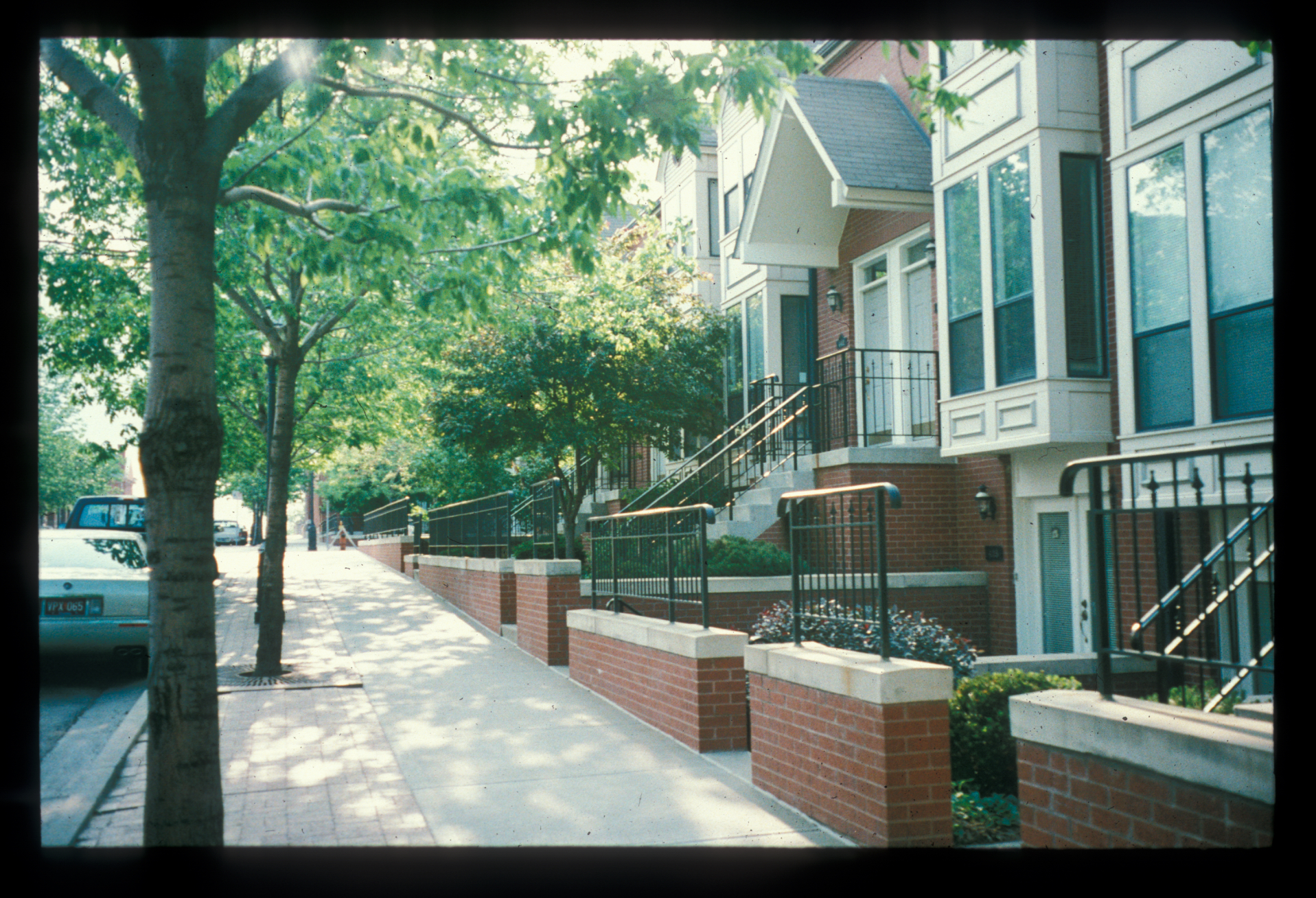 Quality Hill
Quality Hill 1987 Rudy Bruner Award for Urban Excellence - Silver Medal
Quality Hill in Kansas City, Missouri, transformed a deteriorating downtown historic district into mixed-income housing and retail to revitalize the neighborhood. Completed in 1985, the development spans four and a half blocks and includes the renovation of 13 historic buildings and the addition ten new buildings that together provide 363 low- and moderate-income apartments and 52,400 square feet of office and commercial space. The largest adaptive reuse project in the city’s history, Quality Hill helped restore the vitality of the once-thriving district by providing the first downtown housing development in over half a century.
Quality Hill is the result of an innovative partnership between the city, a St. Louis-based private developer, and local businesses and foundations—and the first public-private partnership to succeed in the city’s history. The engagement of a wide variety of public and private participants brought the community together in a process that sparked reinvestment in the central business district while preserving the unique character of the Quality Hill neighborhood.
-
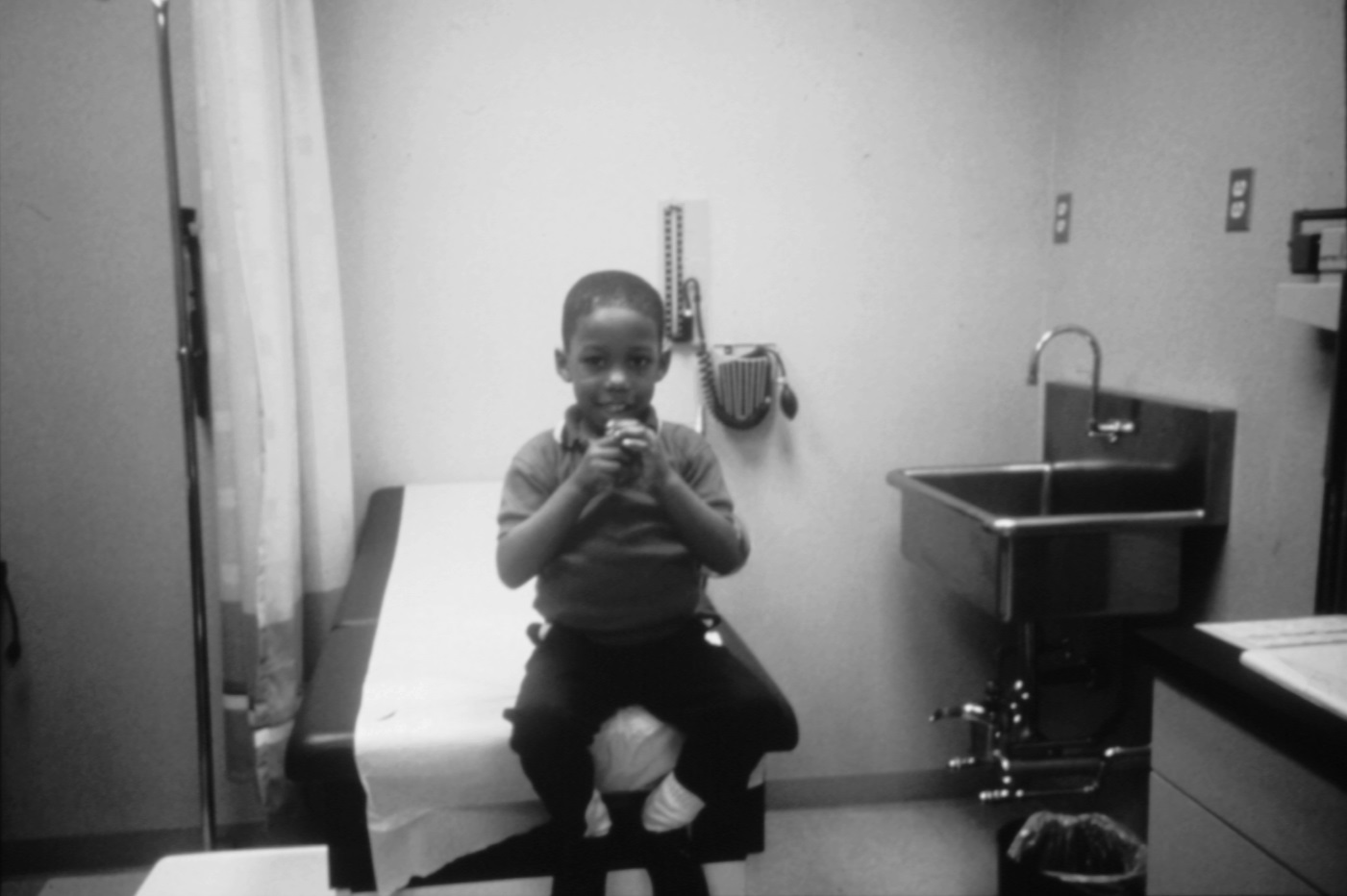 Fairmount Health Center
Fairmount Health Center 1987 Rudy Bruner Award for Urban Excellence - Silver Medal
Fairmount Health Center in Philadelphia is a community clinic providing quality healthcare for area residents regardless of ability to pay. Established by Philadelphia Health Services in 1986 in a former auto parts warehouse, the clinic was created to serve the health needs of the surrounding North Philadelphia community, a struggling and densely populated low-income area where nearly a fifth of the residents were unemployed and without health insurance.
The center repurposed the dilapidated warehouse to create a welcoming, safe, 16,000-square-foot space. Intended to create “an oasis within a decaying cityscape,” the building includes areas for health and dental services as well as education and training. Public spaces are designed to serve as a “neighborhood living room,” and the light and airy lobby includes a play area for children. Local agencies and groups are encouraged to use the facilities for meetings, workshops, and recreational activities to strengthen the clinic’s connection to the community and reinforce its position as a neighborhood hub and place of community pride.
-
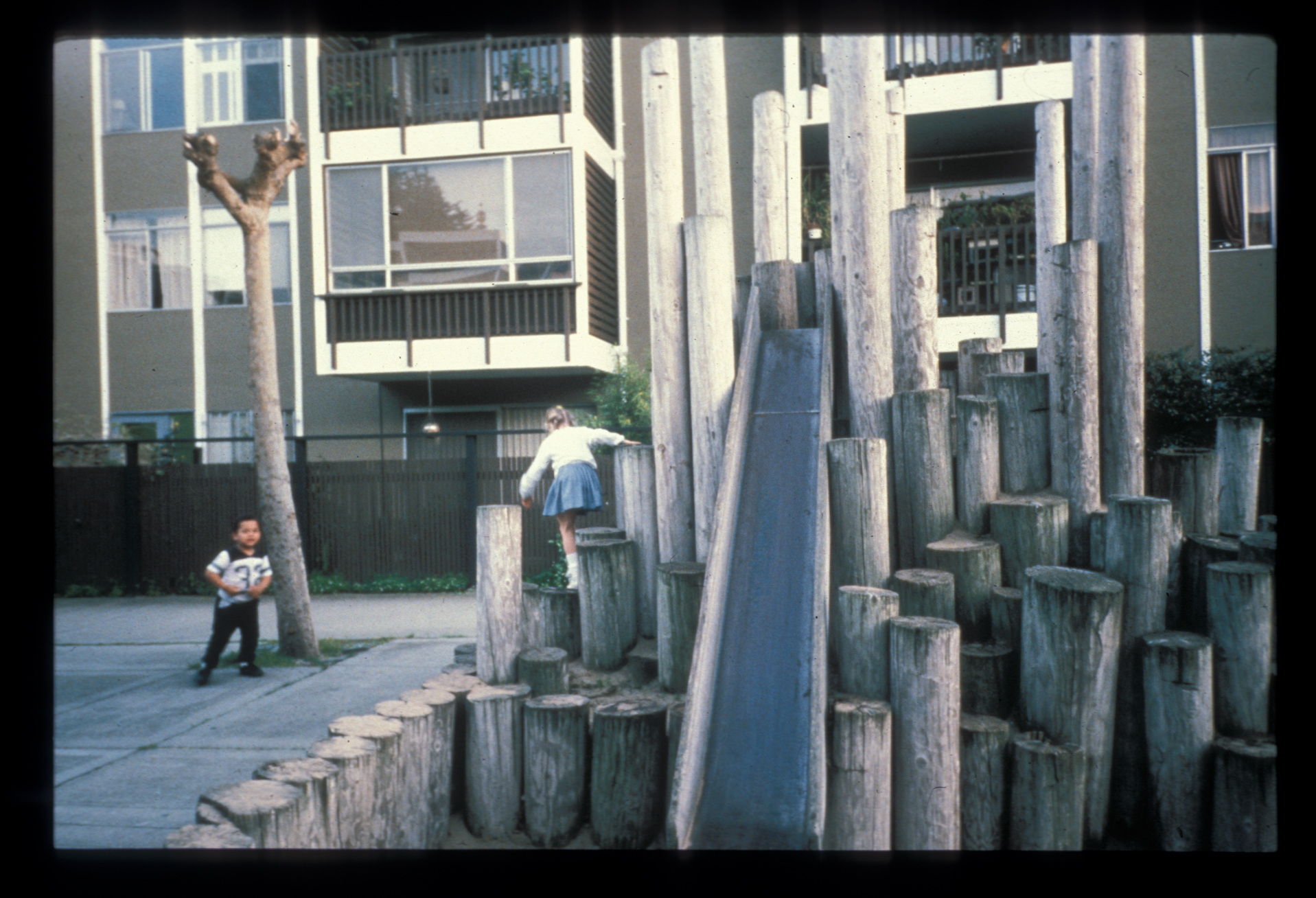 St. Francis Square
St. Francis Square 1987 Rudy Bruner Award for Urban Excellence - Silver Medal
St. Francis Square in San Francisco emphasizes community building in an affordable, cooperatively owned, low-rise family housing complex in the inner city. Its award-winning design includes 299 units clustered in 12 three-story walk-up buildings arranged around three shared courtyards, a playground, and the local YMCA. In contrast to high rise developments geared toward the more affluent, St. Francis Square was designed to attract and retain low-income families and to encourage resident interaction.
Developed in 1963 by the International Longshore and Warehouse Union, and the Pacific Maritime Association, the complex was the first inter-racial housing cooperative on the West Coast. By closing off streets that used to run through the area, the project creates a strong sense of community and better provides for the needs of families with children. The cooperative form of tenancy makes residents stakeholders with a sense of political and financial power despite their modest means and invites tenant leadership and responsibility. St. Francis Square demonstrates that quality low-rise affordable housing, when well designed, can function in densely populated urban areas, facilitate community living, and provide a model for inner-city development.
-
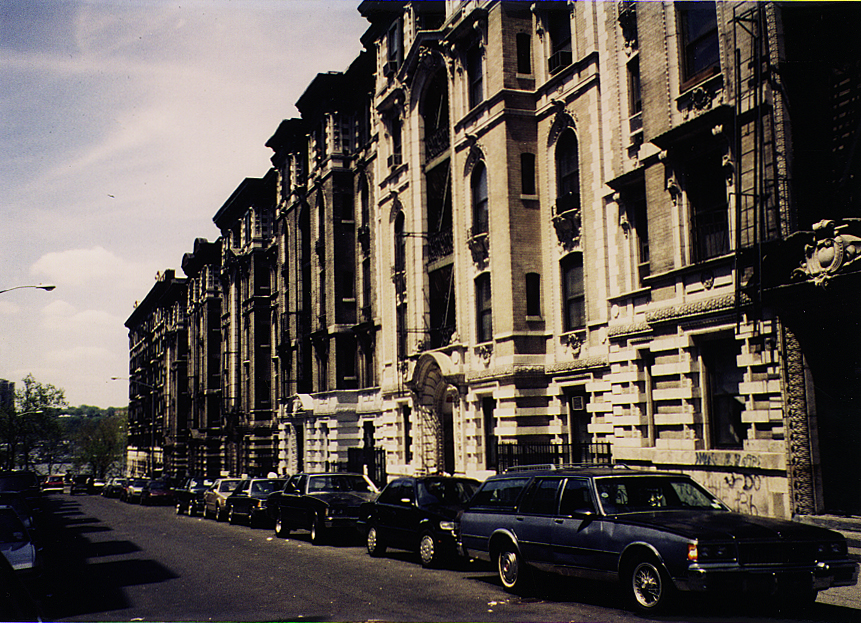 Tenant Interim Lease Program
Tenant Interim Lease Program 1989 Rudy Bruner Award for Urban Excellence - Gold Medal
New York City’s Tenant Interim Lease Program was created as a way for renters to become cooperative owners of their apartments in abandoned low-income buildings. Initiated in 1978, the program was a response to the housing crisis that resulted from landlords abandoning low-income housing units that became too expensive to repair and maintain. Renters in city-owned buildings can form a tenant association and receive training and technical assistance from the Urban Homesteading Assistance Board (UHAB), which oversees the program under the city’s Department of Housing Preservation and Development. Together tenants manage the building and eventually transition to cooperative ownership.
Unlike other city housing programs, the Tenant Interim Lease Program depends upon tenant initiative and persistence, making it a truly empowering experience for those who participate. Self-help is a cornerstone of the program, and participants develop valuable work and leadership skills through the process. Over 240 buildings participated in the first year, with 500 in process at the time of application, making it the city’s largest grassroots low-income housing program.
-
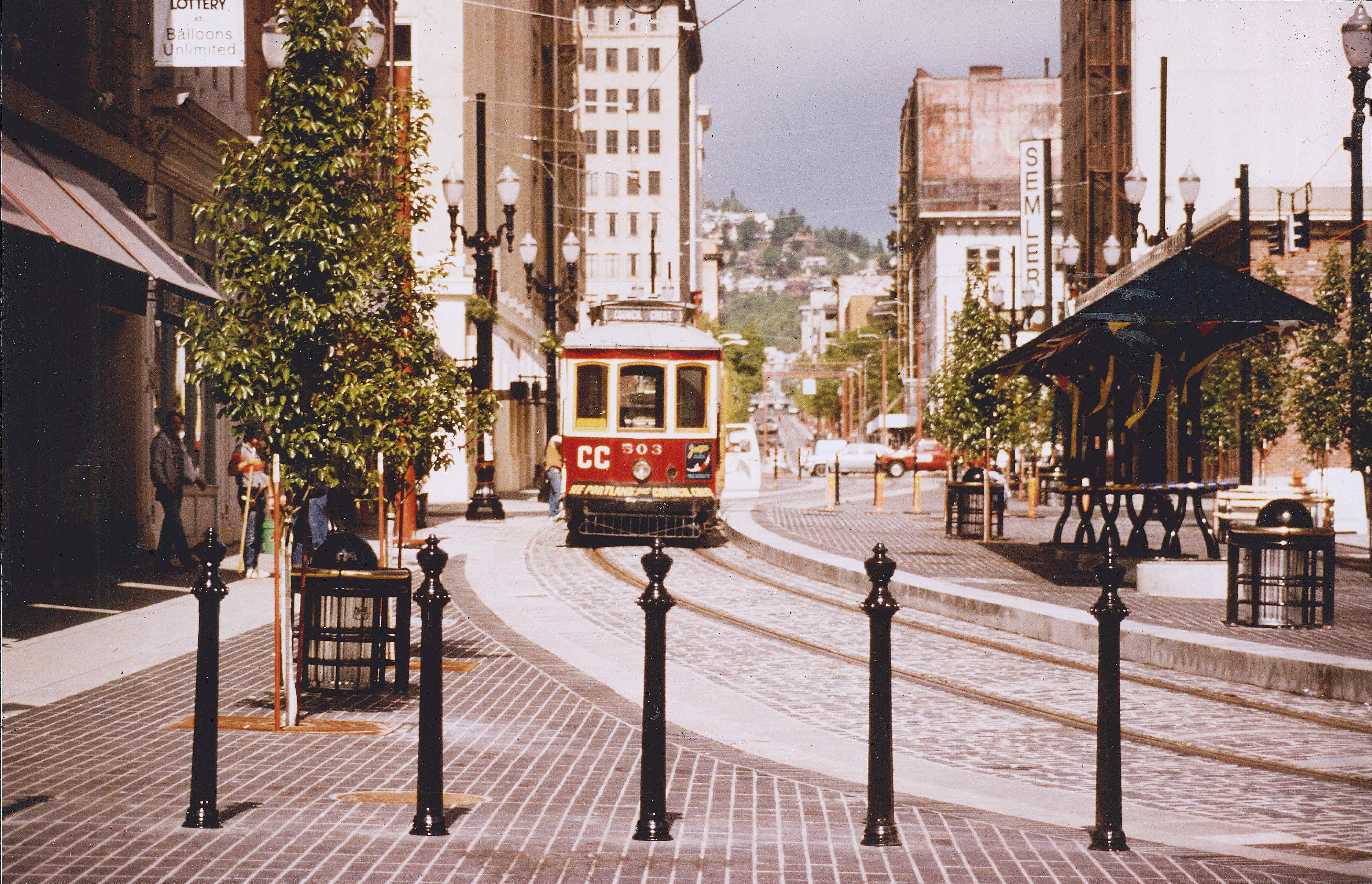 Portland Downtown Plan
Portland Downtown Plan 1989 Rudy Bruner Award for Urban Excellence - Gold Medal
The Portland Downtown Plan in Oregon combined public and private investment and citizen participation to revitalize downtown and reconnect it to the waterfront. Completed in 1972, it established a collective vision and planning process to redevelop downtown over two decades and involved businesses, residents, transit organizations, and multiple levels of government in a joint effort to create an urban community in the heart of the city. The plan leveraged public and private investment to expand local transit, preserve historic buildings, create public spaces including a new riverfront park, foster new housing and retail development, and encourage public art and better streetscape and building design.
The large-scale plan kept a focus on the human scale, allowing the development to have a wider and deeper impact on the community. It has been celebrated for its grassroots participation and its potential to serve as a model for other American cities.
-
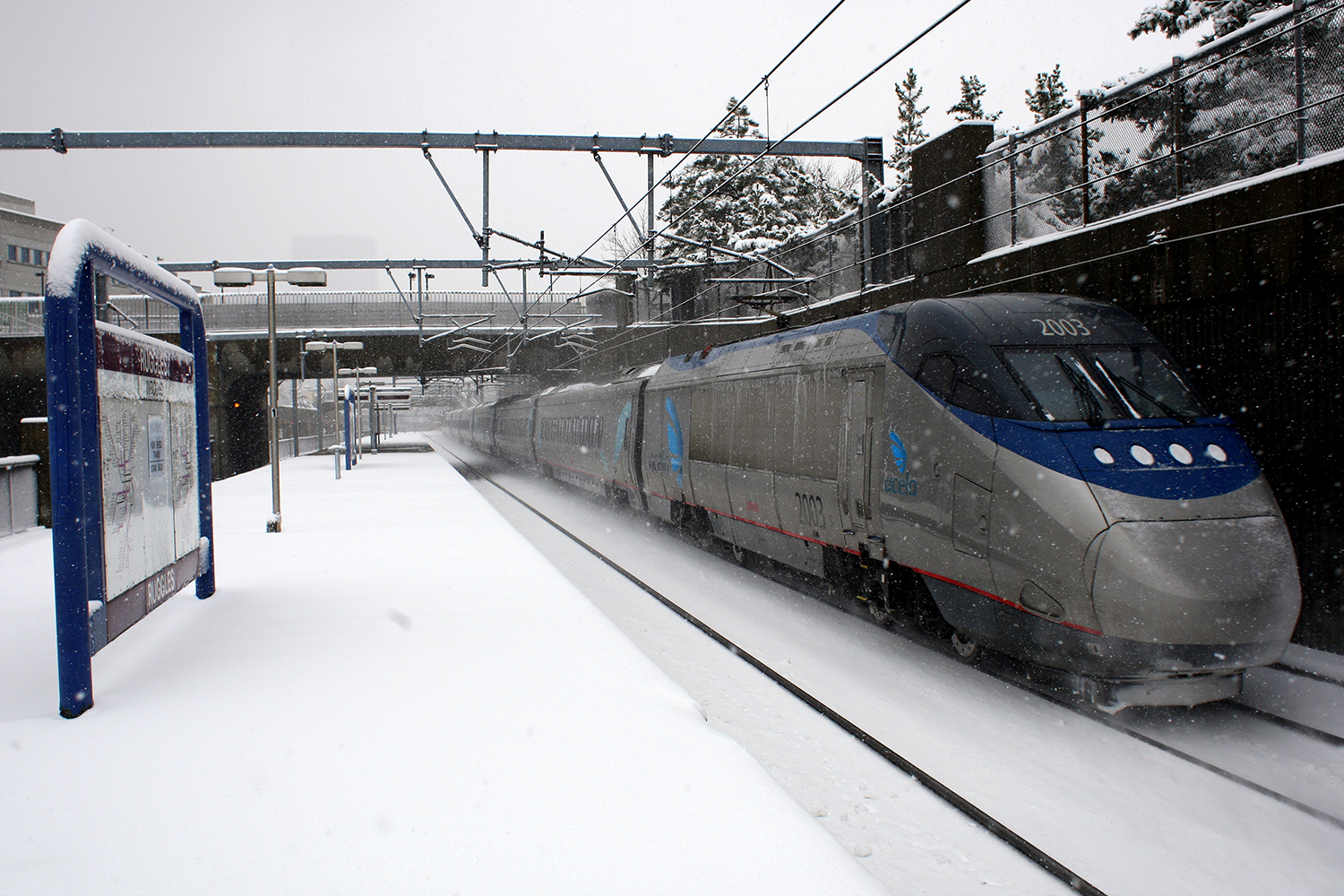 Southwest Corridor Project
Southwest Corridor Project 1989 Rudy Bruner Award for Urban Excellence - Silver Medal
The Southwest Corridor Project in Boston addressed inequitable access to public transit by expanding mass transit and repurposing abandoned land into a park. One of the largest public works projects in Massachusetts’ history, the project connects several outer neighborhoods to each other and downtown with new rail lines, transit stations, and a 52-acre landscaped greenway with trails, community gardens, and recreational facilities.
The project addresses the need for efficient, inclusive transit; the development of jobs; green space and recreation; and safe public spaces. Four lines of commuter rail, Amtrak service, and eight transit stations now connect older and lower-income neighborhoods with downtown and the greater Boston area. Land that had been abandoned when an interstate belt plan was voted down by the community after demolition had already destroyed parts of several neighborhoods was transformed into the Corridor Park, and the $750 million of federal money that had been earmarked for the highway was reallocated for the Southwest Corridor Project. Community participation and leadership and the cooperation of public agencies were vital to the overturning of the highway proposal and the successful development of the corridor.
-
 Stowe Recreation Path
Stowe Recreation Path 1989 Rudy Bruner Award for Urban Excellence - Silver Medal
The Stowe Recreation Path in Vermont is a five-mile multi-purpose riverfront greenway used year-round for a variety of outdoor activities and events. Completed in 1989, the paved trail criss-crosses the West Branch River and preserves open space for everyone to enjoy. With stunning mountain views and access to local restaurants, lodges, and businesses, the public parkway has become the social center of the town. Residents and tourists alike use the popular recreational route for biking, walking, and cross-country skiing as well as organized events and informal social gatherings throughout the year.
Local resident Anne Lusk planned, championed, and implemented the grassroots effort that mobilized community participation and collaboration and organized the donation of 32 parcels of riverfront land. Resident support was strong, and with little federal grant money available, their creative fundraising efforts helped make the path possible. What started out as an answer to the need for a safe route for cyclists and walkers became, according to many, “the best thing to happen to Stowe.”
-
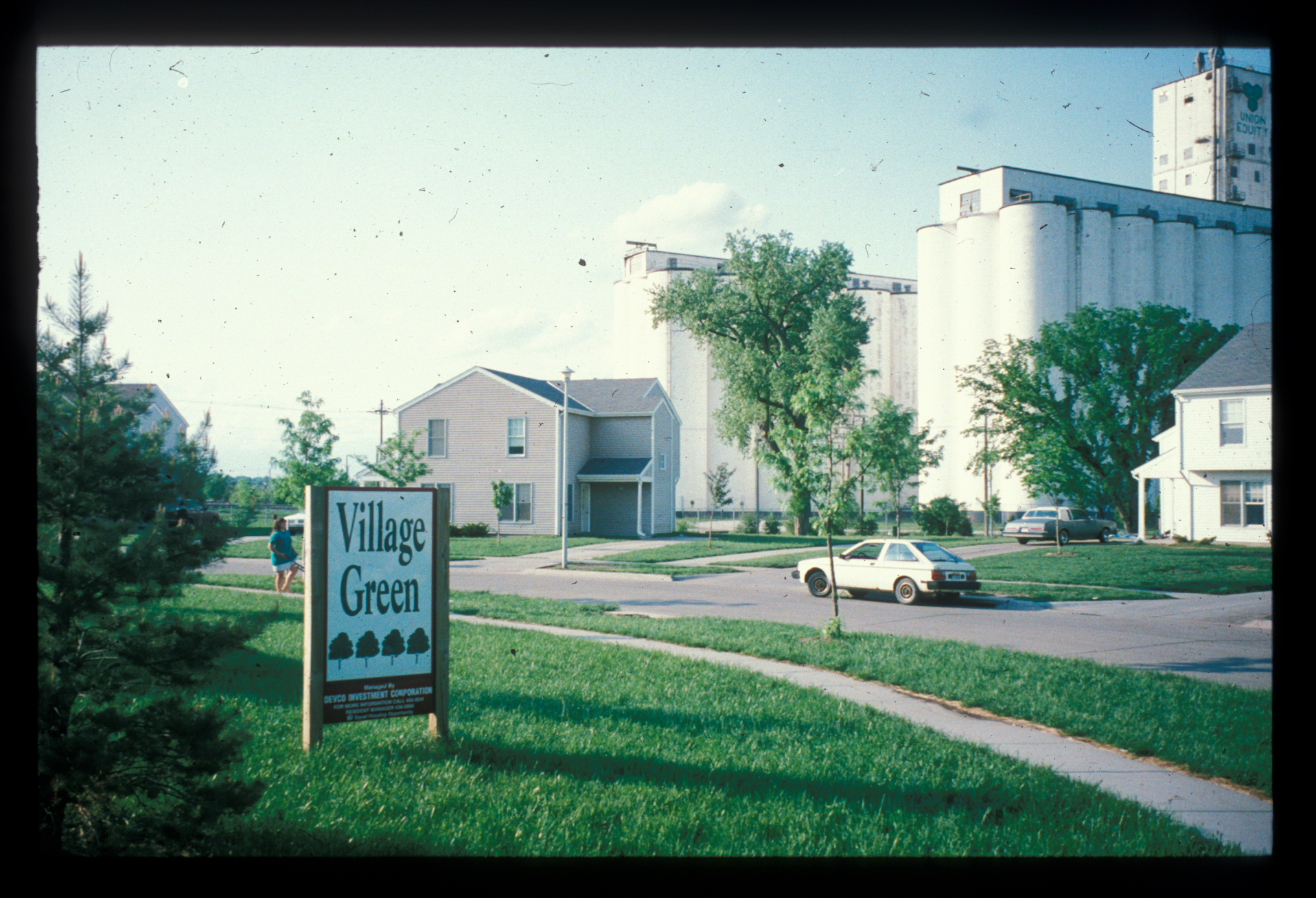 Radial Reuse Project
Radial Reuse Project 1989 Rudy Bruner Award for Urban Excellence - Silver Medal
Created on abandoned land once intended for a highway, the Radial Reuse Project is a four-mile linear park that revitalized neighborhoods in Lincoln, Nebraska. Completed in 1992, the project includes 75 acres assembled by the city over three decades for a proposed highway that was never built. The parkway provides needed recreation and open space and has sparked residential and business reinvestment in three of Lincoln’s older inner city neighborhoods.
After the highway was voted down in 1981, a citizen advisory board known as the Radial Reuse Task Force was formed to develop a plan to repurpose the vacant land. They proposed a new linear park with a bike and walking path that would revitalize adjacent neighborhoods and improve public infrastructure, stimulate private investment, and increase home ownership opportunities for low- and moderate-income families. The project attracted more than $6.4 million in public funding and $17 million in private investment for the park and adjoining neighborhoods as well as programs to foster home ownership and improvement in low- and moderate-income communities.
-
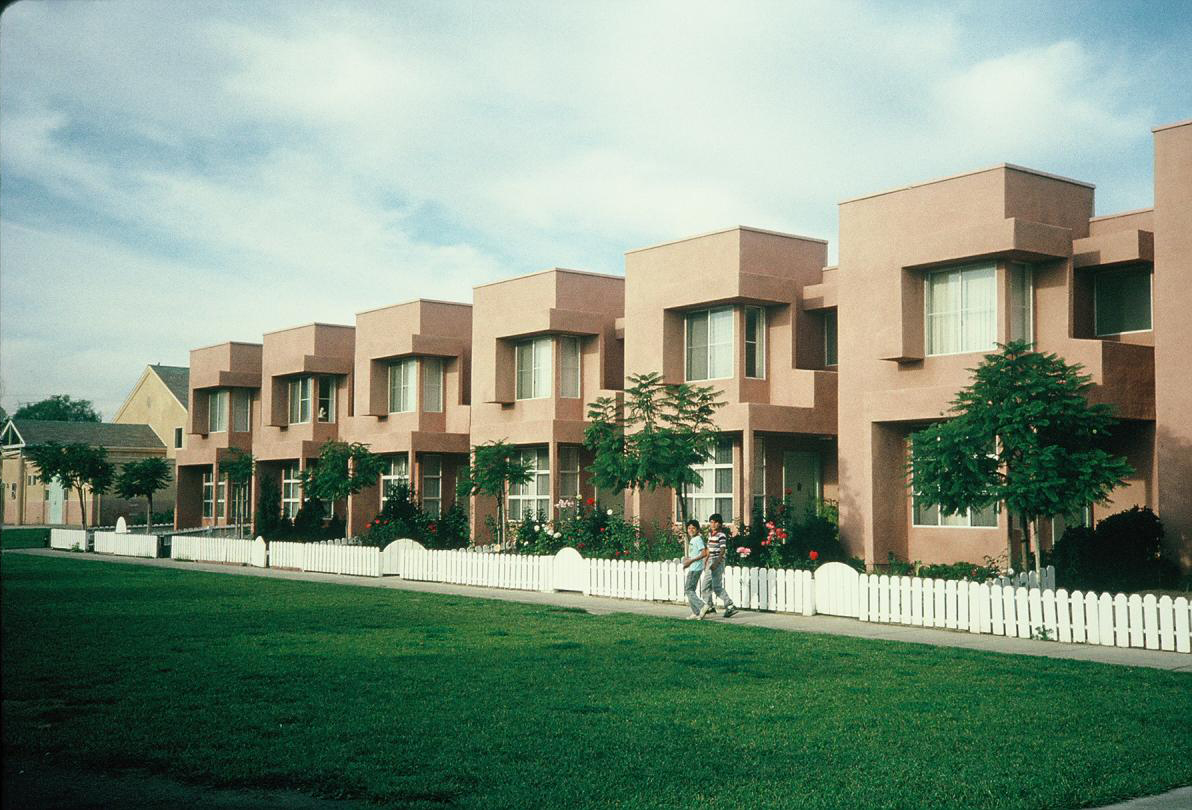 Cabrillo Village
Cabrillo Village 1989 Rudy Bruner Award for Urban Excellence - Silver Medal
Cabrillo Village, a former labor camp in Saticoy, California, is an affordable housing community created and cooperatively owned and managed by farm workers. In 1975 the workers, striking against cheap labor and oppression, faced eviction from the village. Rather than lose their homes, residents joined together to fight the eviction and in 1976 were able to purchase Cabrillo Village. They rebuilt the 1936 labor camp to create an affordable housing cooperative with resident ownership and control.
Over the next three years, the new owners renovated and expanded the existing, dilapidated cabins and built new, energy efficient single-family homes and community facilities. The 25-acre village now includes 160 new and renovated homes and a community center. Cultural, environmental, and family values were top priorities in the resident-driven design and construction of the new housing units and rehabilitation of the older cabins. The new structures incorporate passive and active solar heating systems with contemporary adobe styling.
-
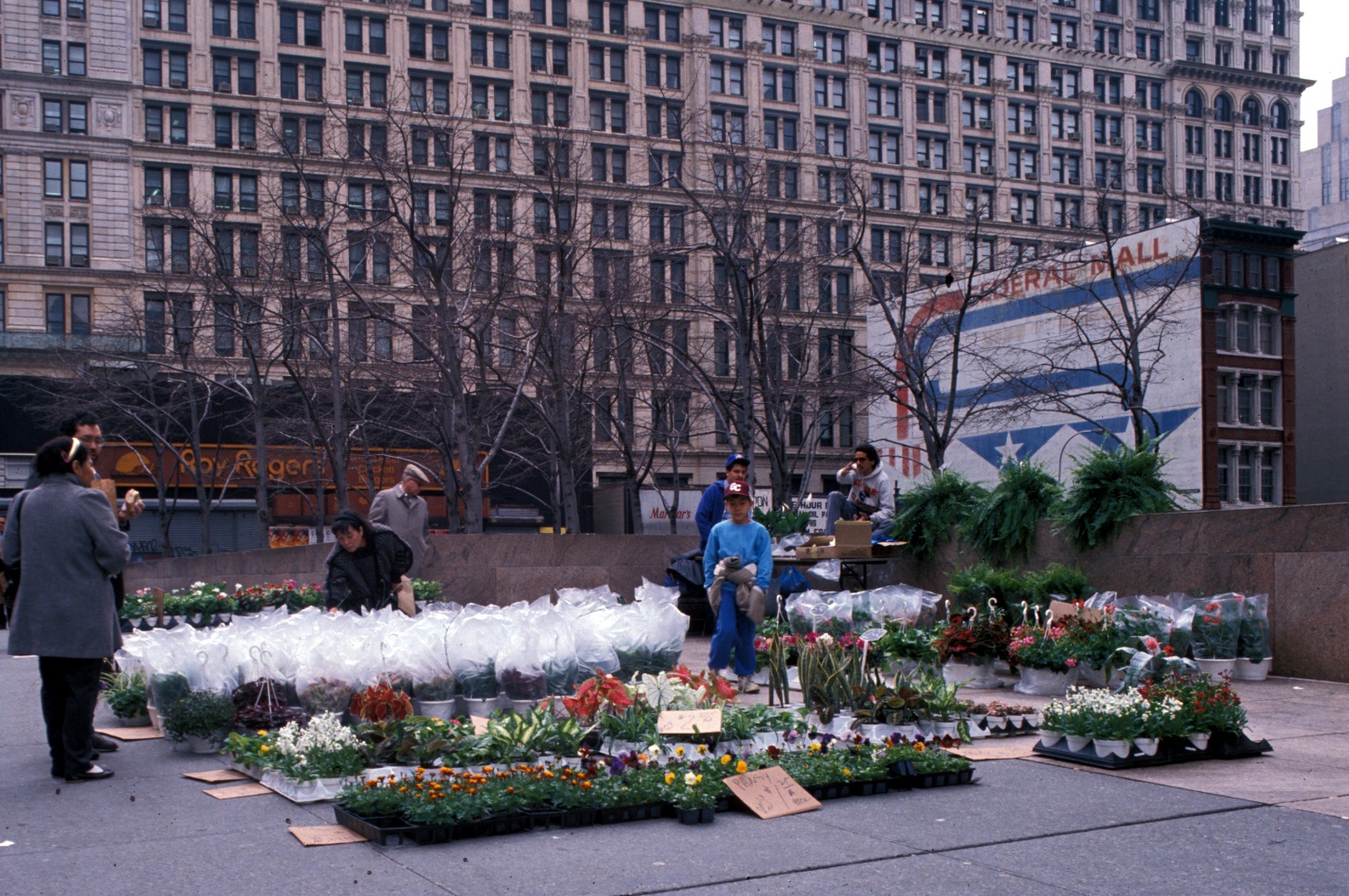 Greenmarket
Greenmarket 1991 Rudy Bruner Award for Urban Excellence - Gold Medal
Greenmarket is a coalition of outdoor farmers markets bringing fresh, affordable food to New York City and supporting the revitalization of Union Square. The seasonal markets operate between one to three days a week at 18 different locations throughout the city to provide residents with inexpensive, high-quality products and produce from local family-owned farms. Greenmarket has also significantly contributed to improvements in and around Union Square Park, its largest and most successful market site.
The market program was launched by the New York Council on the Environment with support from the New York City Departments of Parks and Recreation and Transportation as a way to connect local consumers with locally grown fresh produce, support and sustain small farms, and encourage farmland preservation in nearby rural areas. A coupon program helps low-income residents enjoy market offerings, and some sites operate year-round.
-
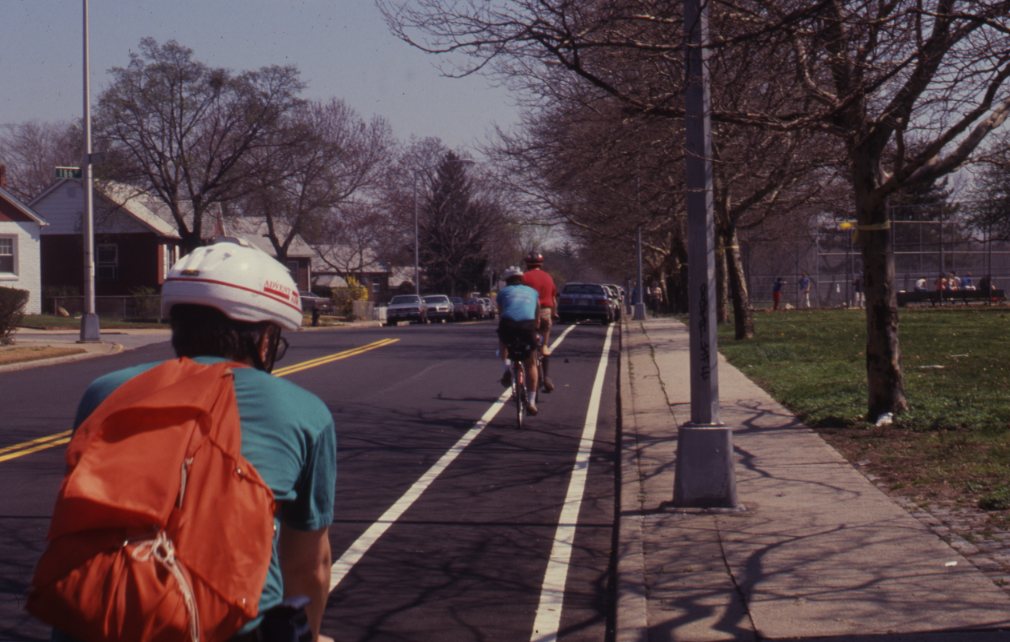 Brooklyn-Queens Greenway
Brooklyn-Queens Greenway 1991 Rudy Bruner Award for Urban Excellence - Silver Medal
The Brooklyn-Queens Greenway converted 40 miles of underused land into a linear park connecting neighborhoods and treasured New York City institutions. Stretching from Coney Island to Little Neck Bay, the 5,000-acre greenway and bicycle and pedestrian path links 13 parks and locations of historical, cultural and environmental significance including museums, lakes, botanical gardens, and the sites of the 1939 and 1964 World’s Fairs.
The project was initiated in the mid-1980s by the Neighborhood Open Space Coalition and community members who began brainstorming about how to link some of the best environmental, educational, historical, and recreational resources in Brooklyn and Queens. Open year-round, the multi-purpose greenway is used by the four million residents of Brooklyn and Queens for a variety of activities. It has increased the quality of open, green spaces in the city and provides much needed recreational space to underserved communities.
-
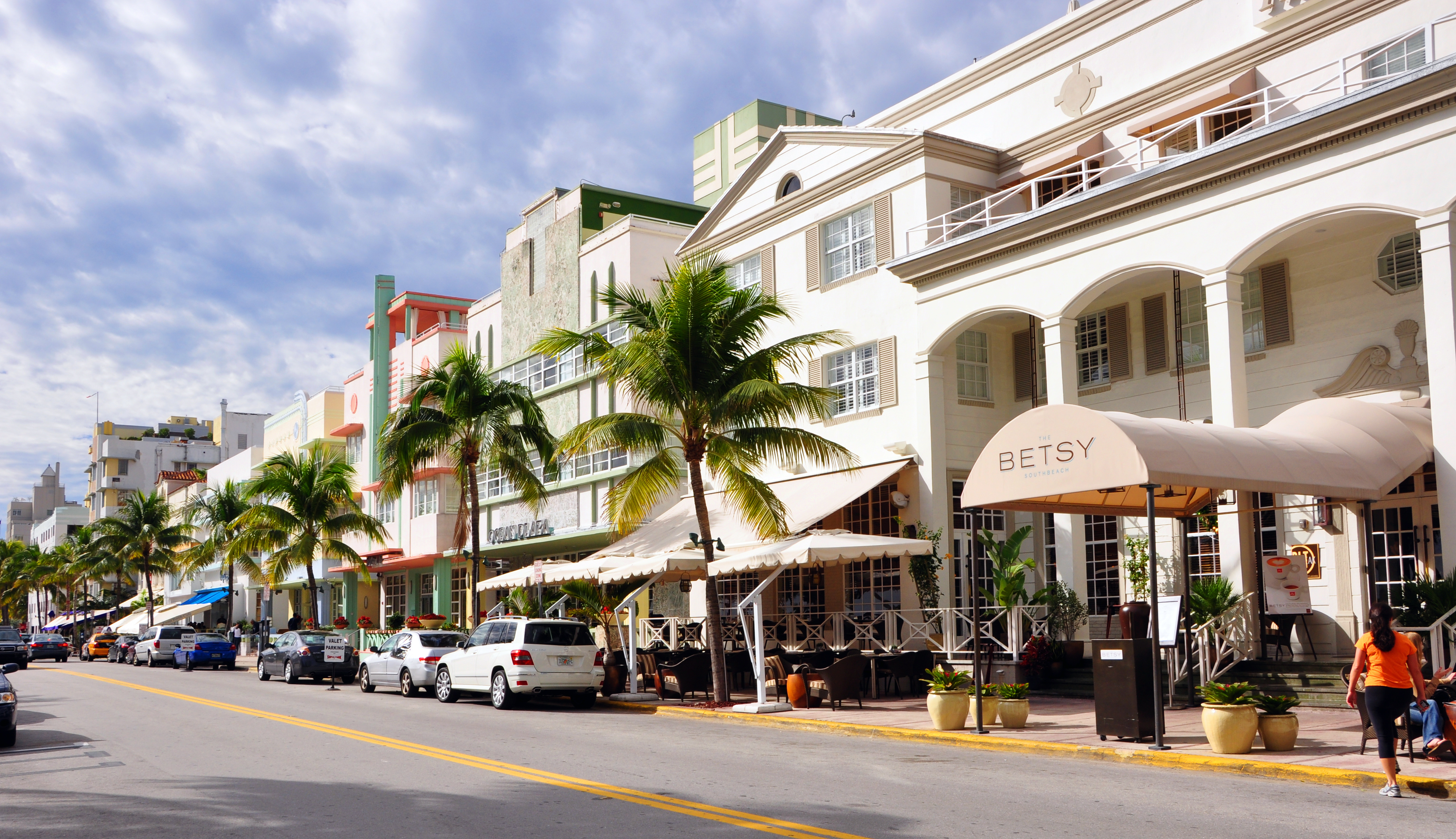 Ocean Drive Improvement Project
Ocean Drive Improvement Project 1991 Rudy Bruner Award for Urban Excellence - Silver Medal
The Ocean Drive Improvement Project combined preservation and public-private development to revitalize Miami Beach’s historic Art Deco neighborhood. The 26-acre oceanfront historic district includes 15 city blocks with Art Deco hotels and apartment buildings and a new public park. The district has become a vital entertainment and tourist center, garnering international attention for its successful integration of residential, retail, and commercial reinvestment.
Completed in 1990, the project renewed interest and investment in a historic and architecturally significant section of Miami. A total of 28 historic buildings were rehabilitated, 50 new restaurants opened, and $4 million of public money was raised, including a $3 million bond issue that financed infrastructure improvements. The project’s success is the result of rigorous planning, zoning, and historic preservation regulations, physical improvements, fundraising, and promotional advertising.
-
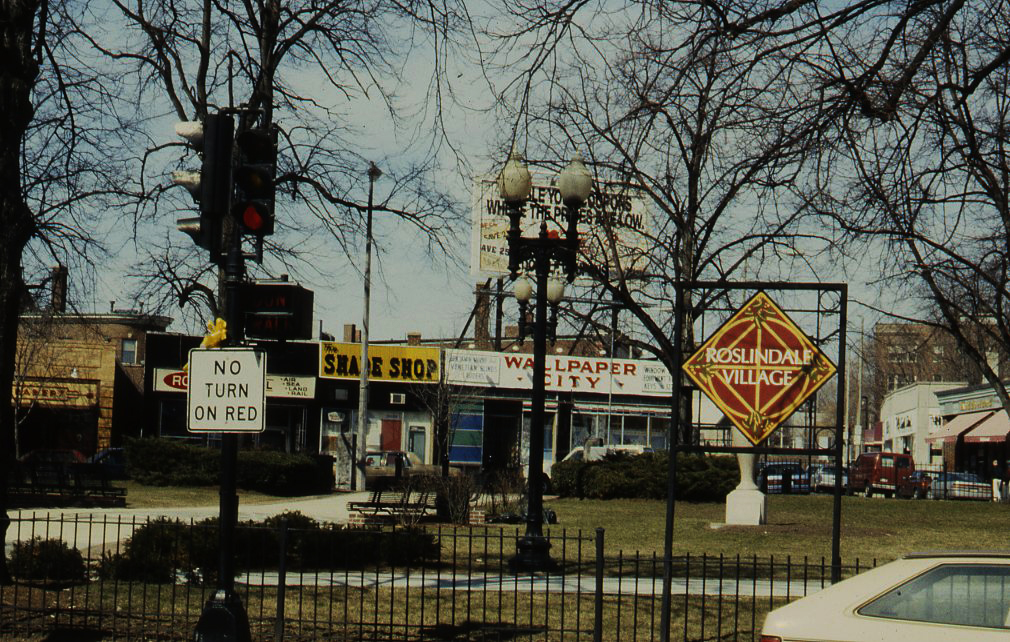 Roslindale Village Main Street
Roslindale Village Main Street 1991 Rudy Bruner Award for Urban Excellence - Silver Medal
Roslindale Village Main Street is a comprehensive, community-based revitalization program for a southwest Boston neighborhood business district. It was initiated in 1985 by Roslindale Village Main Street (RVMS), a nonprofit community group supported by the National Trust Main Street Urban Demonstration Program, which promotes the local business district as destination and community center through advocacy, events, and investments in the physical environment.
One of the first urban main street programs in the US, the RVMS project created an organizational framework for community outreach and engagement along with a master plan and programs for physical improvements that included the preservation of historic storefronts. The first three years saw over $5 million in new investments, including the rehabilitation of 43 commercial buildings and restoration of 33 storefronts and signage, and businesses and residents have benefited from improvements to streets, sidewalks, lighting, and public spaces. Nearly 30 new businesses opened in the village while old ones expanded, together creating over 132 new jobs. Meanwhile the RVMS keeps businesses and residents active and interacting with a year-round calendar of events including cleanup and recycling days, famers markets, and bingo.
-
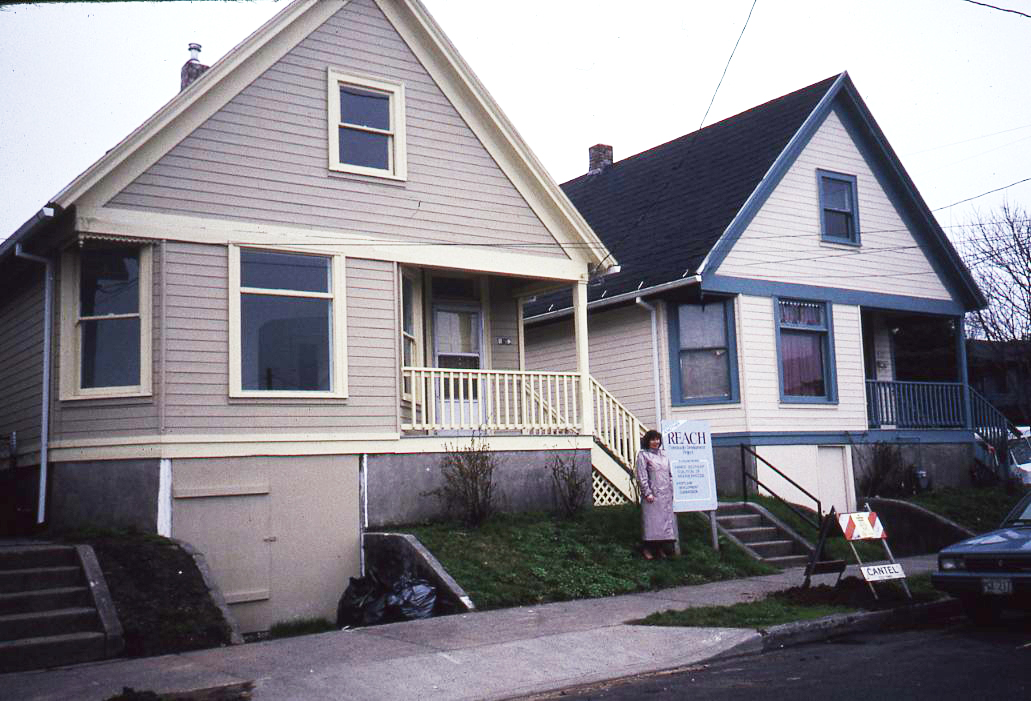 West Clinton Action Plan
West Clinton Action Plan 1991 Rudy Bruner Award for Urban Excellence - Silver Medal
The West Clinton Action Plan revitalized a low-income neighborhood in Portland, Oregon, improving housing and increasing community involvement and pride. REACH, a nonprofit community development organization which initiated the project in 1990, worked extensively with local residents to identify a target area and goals and develop and implement a plan for improvements that focused on owner-occupied and rental housing rehabilitation and community-strengthening programs.
The nearly $1.4 million project was financed with support from local government and financial institutions. It included the purchase and renovation of deteriorating and vacant structures in the southeast Portland Hosford Abernathy neighborhood, tree planting (carried out by neighborhood volunteers), and the creation of a mini-park. New infill housing was built in partnership with a community college construction class. The extremely inclusive and participatory process became a model for community planning in Portland neighborhoods.
-
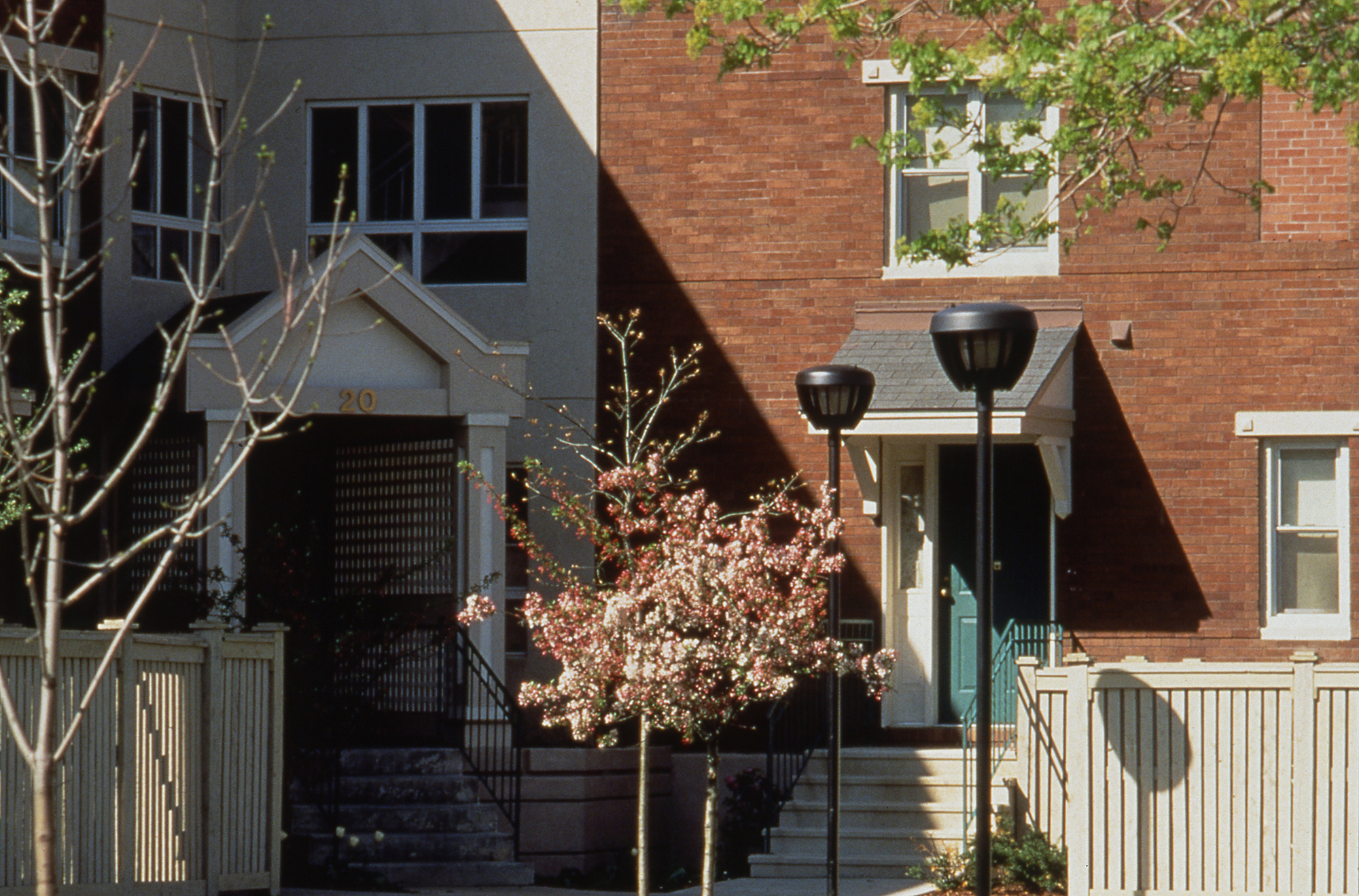 Harbor Point
Harbor Point 1993 Rudy Bruner Award for Urban Excellence - Gold Medal
Harbor Point is the redevelopment a 1950s public housing project into a racially and economically diverse community overlooking Boston Harbor. The redevelopment transformed Columbia Point, a dangerous and deteriorated 1,504-unit public housing project serving mainly low-income minorities, into a fully renovated 1,283-unit mixed-income community with new amenities and integrated social services. The 50-acre community, now safe and attractive, was completed in 1991.
In order to attract and support a mixed-income community, the redevelopment incorporated significant physical changes as well as a variety of social support services. The developers worked with existing tenants to ensure they had a voice in the design and planning process and an ongoing management role. The $201 million development is organized around the water and includes a three-block-long landscaped mall with a health center and youth center leading to a bay-front park. Street grids were reoriented to reveal waterfront views, and the number of units was scaled back to increase unit size and quality. Existing structures were remodeled and new buildings designed to offer a diversity of unit types, building scales, and materials. Subsidized units blend in seamlessly, undistinguishable from market-rate apartments, for a shared sense of community.
-
 New Community Corporation
New Community Corporation 1993 Rudy Bruner Award for Urban Excellence - Gold Medal
New Community Corporation (NCC) offers low-income housing and social services to revitalize Newark, New Jersey’s Central Ward. Born in response to the riots of 1967, the NCC rebuilt the devastated Central Ward through the creation of the oldest and largest community development corporation in the country. The NCC provides a range of comprehensive and innovative services to meet a variety of urban needs including low-income and transitional housing, childcare, employment, job training, educational opportunities, and social and health care services.
Dedicated to improving the quality of life in the Central Ward, this grassroots redevelopment venture provides housing for over 6,000 individuals in apartments and homes contained within 15 housing developments. The 2,498 units range from senior citizen high rises, to family town houses, to mid-rise mixed tenancy buildings that mindfully preserve historic sites. The NCC also promotes economic recovery and stability in the area, employing 1,200 people in several for-profit businesses, seven childcare centers, a school for 300 students, and multiple assistance agencies.
-
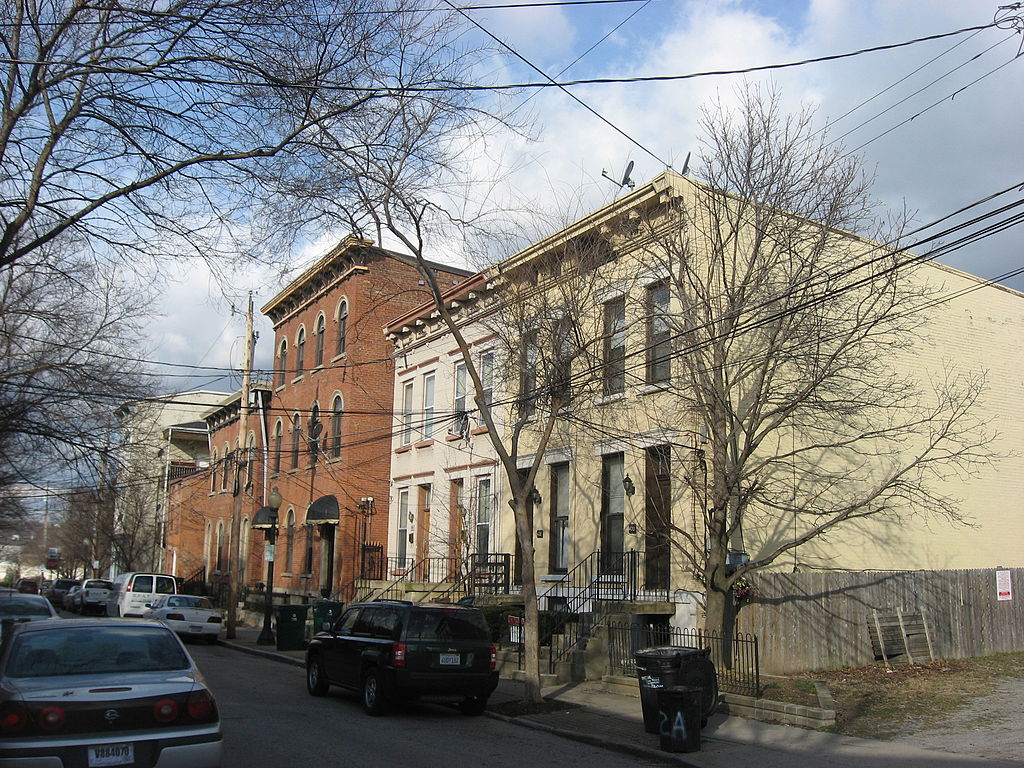 Betts-Longworth Historic District
Betts-Longworth Historic District 1993 Rudy Bruner Award for Urban Excellence - Silver Medal
The Betts-Longworth Historic District in Cincinnati combines historic preservation and new development to successfully revitalize a small downtown neighborhood. Now a thriving low- and middle-income neighborhood, the project promotes socio-economic diversity and stability in an area once on the verge of complete demolition. By the end of 1993, the district included 240 rehabilitated apartment units; 77 single-family homes; 20,000 square feet of rehabilitated office space; 4,000 square feet of rehabilitated retail space; 370 parking spaces; and a park designed, constructed, and maintained by middle school students.
The initiative has sparked economic growth by encouraging small-scale private development and the participation of minority developers and contractors, and economic and racial diversity in the area are increasing. The plan includes a marketing and public relations strategy to attract residents and investors and a financing strategy to reduce investment risk through a five-bank loan consortium. The project has succeeded in saving most of the district’s historic buildings, and new buildings are designed to fit the rich character of the neighborhood.
-
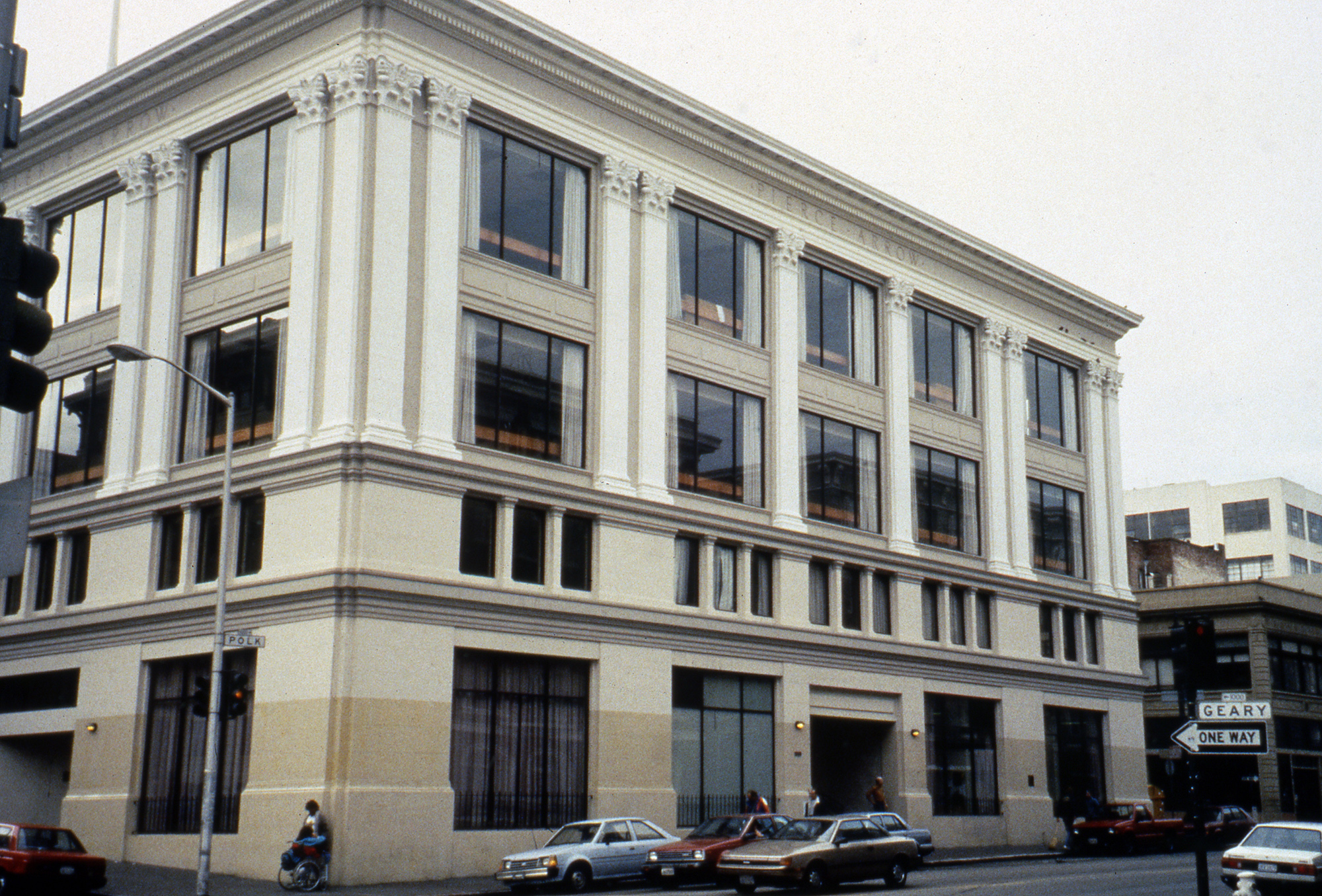 Beyond Homelessness
Beyond Homelessness 1993 Rudy Bruner Award for Urban Excellence - Silver Medal
Beyond Homelessness offers a comprehensive approach to homelessness in San Francisco through programs that provide food, shelter, social services, and housing. The larger of two multi-service centers, for example, offers 225 shelter beds, toilets and showers, and laundry facilities as well as a day-lounge with a 95-person capacity. Housed in a repurposed and renovated concrete frame warehouse, the center is a welcome alternative to traditional shelters. A smaller drop-in center is open 24 hours a day, and an outreach center located at the bus terminal offers counseling, benefits assistance, clothing, and mental and physical health referrals. Multiple hotel projects provide temporary and permanent housing along with support, including childcare and educational opportunities, to help residents achieve stability.
Beyond Homelessness programs are rooted in San Francisco’s 1989 Beyond Shelter plan, which aims to reduce the homeless population by assisting the homeless in finding needed services and permanent housing, acquiring and rehabilitating low-income housing, and stabilizing income through job training.
-
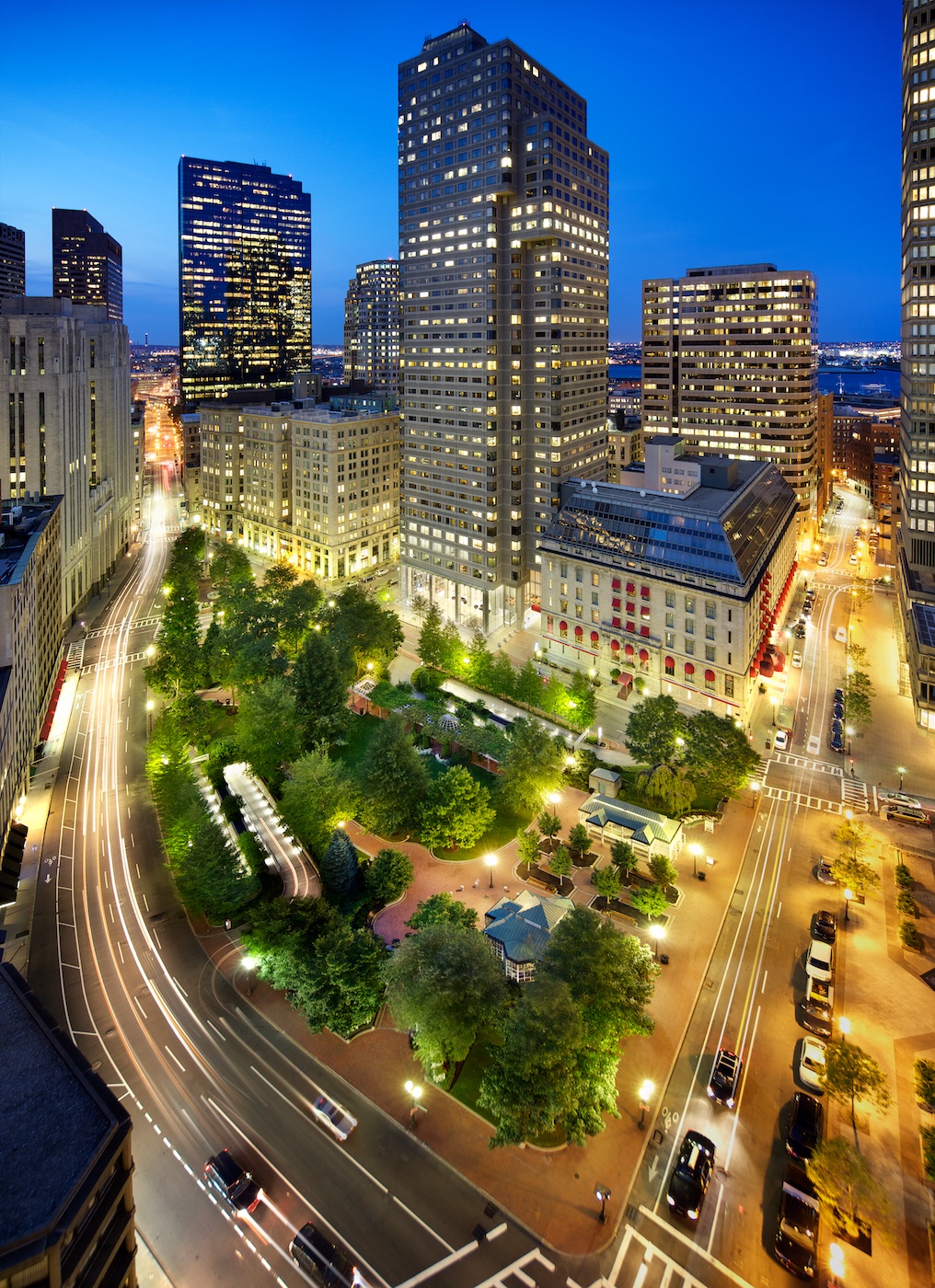 The Park at Post Office Square
The Park at Post Office Square 1993 Rudy Bruner Award for Urban Excellence - Silver Medal
The Park at Post Office Square converted an abandoned parking garage into a 1.7-acre park that provides much-needed green space in downtown Boston. A landmark of urban landscape design, the park is a green oasis and popular destination in the heart of the financial district. A seven-story underground parking structure provides convenient access to the park and surrounding neighborhood and ongoing revenue for the project.
The park was created through an innovative public-private partnership at no cost to the public. The design emphasized providing a variety of opportunities for rest and recreation, creating visual and spatial relief from the park’s urban surroundings, incorporating abundant and varied flora, and providing a focal point for the financial district. The meticulously maintained park features a walk-through sculptural fountain and a 140-foot-long trellis over a pedestrian walkway. Safety is enhanced by keeping all points of the park open and within sightlines of the street, and a glass pavilion houses a year-round café. The park’s location in the midst of a heavily-trafficked district serves as a model for other cities attempting to integrate green space in crowded downtown areas.
-
 Maya Angelou Community Initiative
Maya Angelou Community Initiative 1995 Rudy Bruner Award for Urban Excellence - Gold Medal
The Maya Angelou Community Initiative is a grassroots redevelopment plan to provide long-term affordable housing to female-headed households in Portland, Oregon. The initiative renovated a deteriorated apartment complex to provide 42 units of sustainable, long-term, low-income housing primarily for households headed by single females. Supported by the nonprofit Housing Our Families, the initiative has successfully redeveloped an underused section of Portland’s troubled Boise neighborhood through an exceptionally democratic and inclusive process engaging all members of the community.
Evidence of the initiative’s success include increased home ownership, reduced crime, significant growth of community organizations, and a greater sense of community. Ongoing programs continue to make improvements to the neighborhood and support economic growth in the area.
-
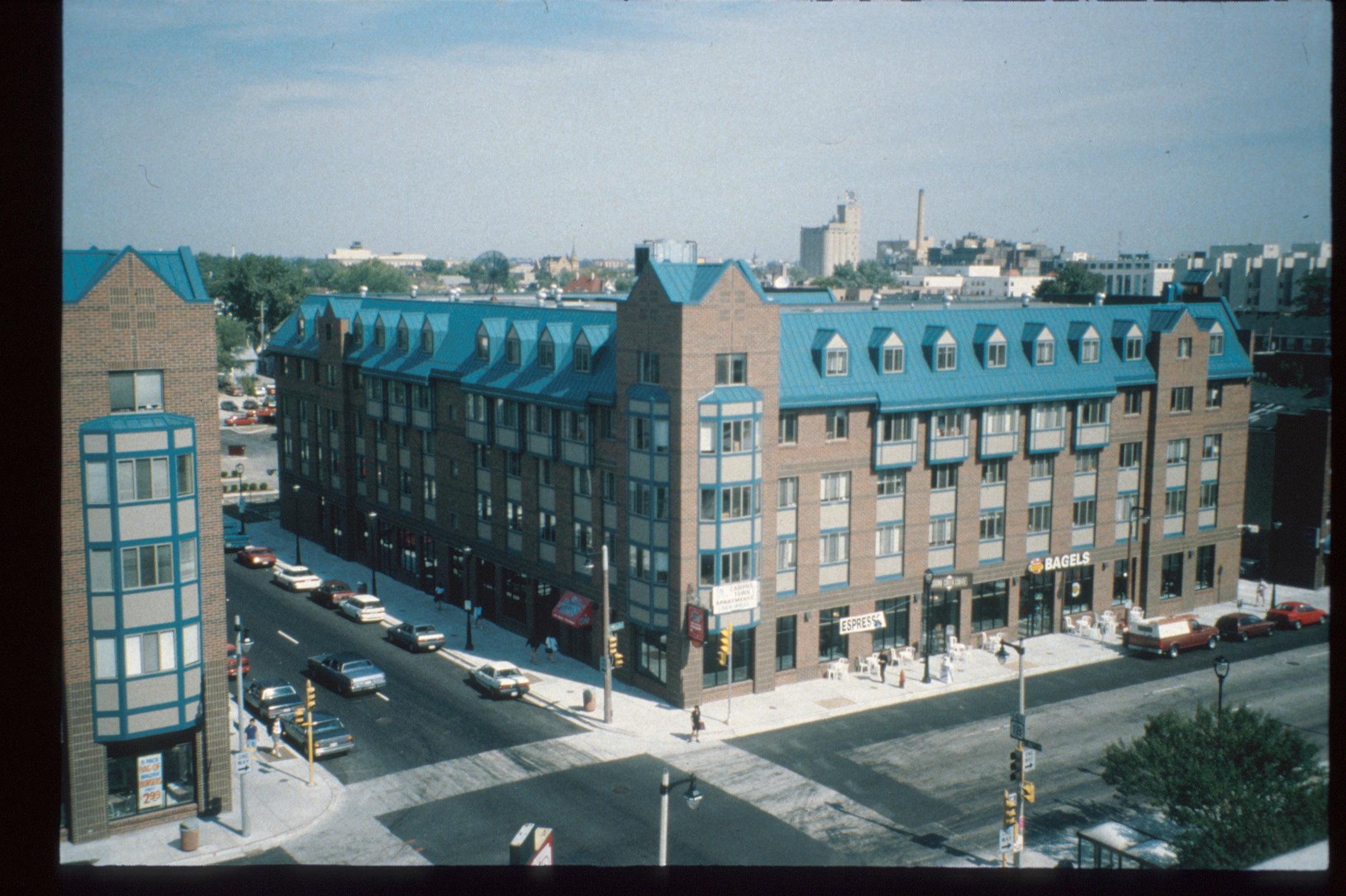 Campus Circle
Campus Circle 1995 Rudy Bruner Award for Urban Excellence - Silver Medal
Campus Circle, launched by Milwaukee’s Marquette University, revitalized a low-income neighborhood with quality mix-income housing for students and families. The university joined forces with area businesses, community organizations, and residents to develop a comprehensive approach to transforming a 90-square-block area adjacent to its campus. The $9 million university investment included three main components: building new off-campus student and staff housing, rehabilitating low-cost housing for neighborhood residents, and revitalizing commerce by developing commercial properties, all while reducing crime and increasing community involvement.
Campus Circle purchased over 150 properties in the area and created over 88,000 square feet of new commercial space. Crime is down significantly and social services organizations and a police station have been integrated into the circle. More than 150 units for students have been built or renovated, and 188 units of affordable housing for residents was rehabilitated without increasing rents.
-
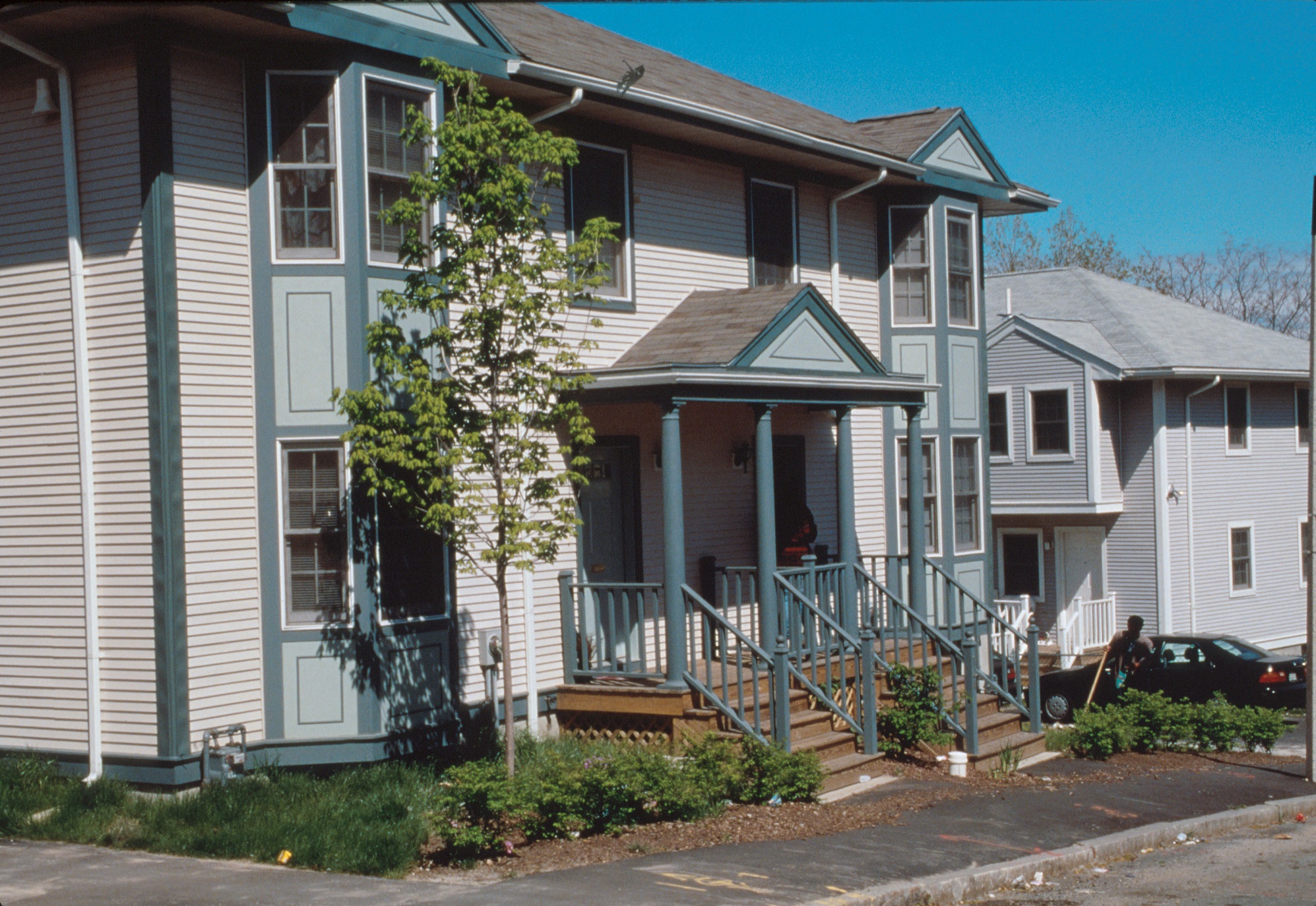 Dudley Street Neighborhood Initiative
Dudley Street Neighborhood Initiative 1995 Rudy Bruner Award for Urban Excellence - Silver Medal
The Dudley Street Neighborhood Initiative (DSNI), a Boston community-based organization, empowered residents to revitalize a depressed neighborhood. With nearly 2,000 members, DSNI includes residents of the Roxbury and Dorchester areas near downtown and representatives of local social service agencies, businesses, and other community organizations. In its mission to reclaim the neighborhood, it purchased vacant land, established a community land trust, and replaced vacant lots and deteriorated buildings with affordable housing units, parks and playgrounds, businesses, and community facilities.
DSNI is an extraordinary example of grassroots, bottom-up organizing. To carry out its comprehensive revitalization plan, it partnered with philanthropists, government officials, banks, businesses, and community development organizations to reverse decades of neglect and disinvestment in this area of Boston. Its redevelopment efforts put a stop to a series of arson fires, cleaned up derelict sites, and built quality housing with ownership opportunities for low-income families, including 36 units of owner-occupied housing at Winthrop Estates.
-
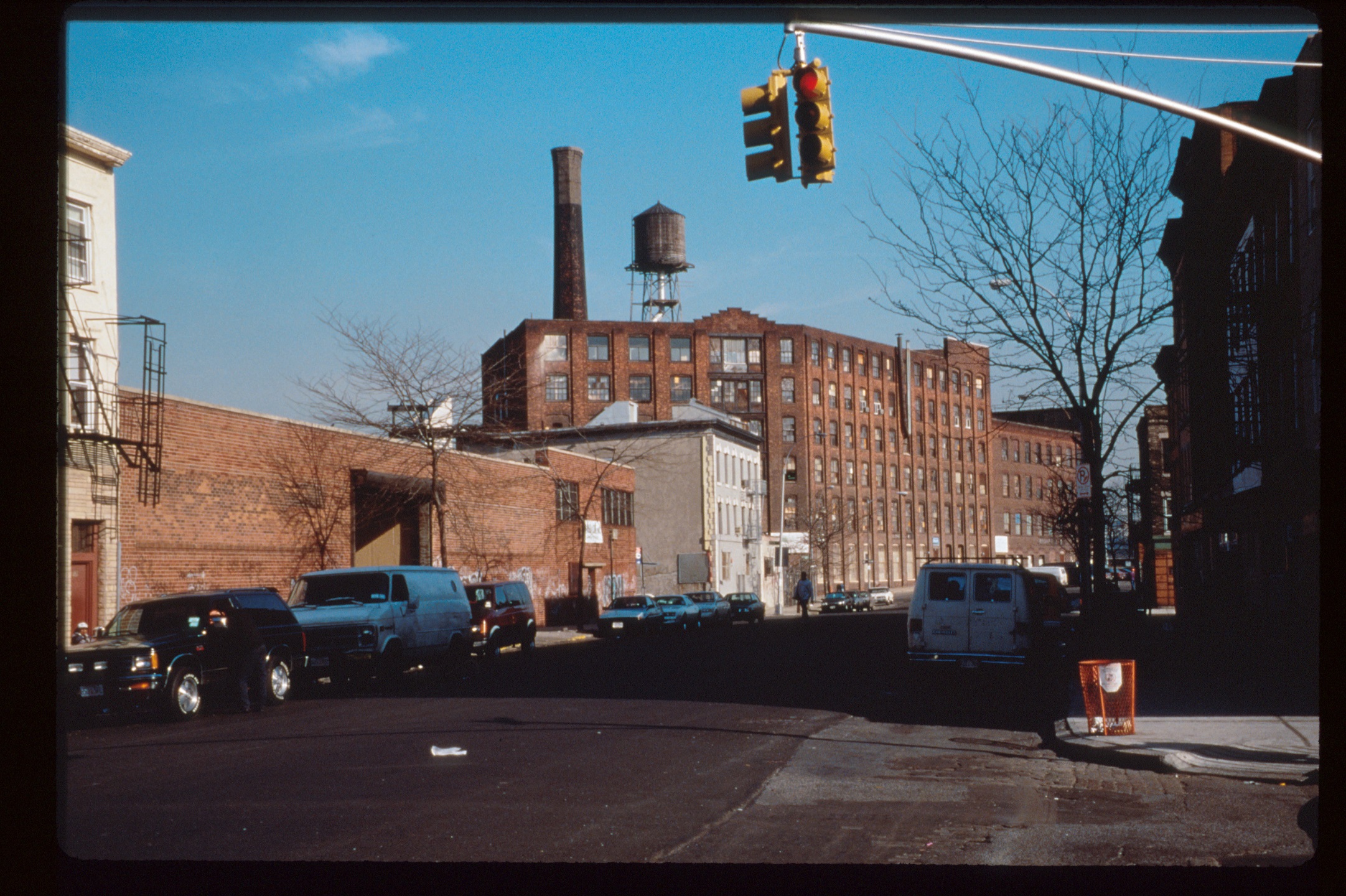 Greenpoint Manufacturing and Design Center
Greenpoint Manufacturing and Design Center 1995 Rudy Bruner Award for Urban Excellence - Silver Medal
The Greenpoint Manufacturing and Design Center (GMDC) in Brooklyn, New York, is an arts and industry complex with incubator and studio space for artisan businesses. The center was created and is managed by a collective of woodworking manufacturers, crafts people, and artisans who formed the collective to purchase their building—a historic mill in Greenpoint—and save the complex when ownership of the building was transferred to the city.
GMDC preserved the historic building and transformed it into a thriving artist and artisan network where expertise, equipment, and supplies are shared and sold. The renovation established space for incubator workshops and studios with easy access to downtown markets. The space protects 21 businesses, creates jobs, and provides support services and workspace for small artisan businesses. GMDC offers an unusual but highly successful model for small-scale, urban industrial cooperatives. It has since expanded to rehabilitate six other manufacturing buildings to create similar spaces for artisans and manufacturing entrepreneurs.
 Pike Place Market 1987 Rudy Bruner Award for Urban Excellence - Gold Medal Pike Place Market in Seattle renovated historic waterfront buildings to create a thriving farmers market with retail, low-income housing, and social services. Much more than a market, the project spans seven acres and includes 300 businesses and 750 subsidized housing units in an interdependent network of business owners, consumers, and neighbors. The Market Foundation, created to support local residents, offers a wide a variety of social services including a health clinic, food bank, child care center, and senior center to strengthen and serve the community. The farmers market was established in 1907 by local farmers in response to steep price increases in produce. The project preserves the founders’ commitment to creating and serving community by combining retail with residential units and social services. At the same time, the project preserves a section of the city’s waterfront, mixing new development with the adaptive reuse of several blocks of historic buildings. The market’s programming reflects its intention to attract a diverse population to the venue, where people can still “meet the producers” in the oldest continually run farmers market in the country.
Pike Place Market 1987 Rudy Bruner Award for Urban Excellence - Gold Medal Pike Place Market in Seattle renovated historic waterfront buildings to create a thriving farmers market with retail, low-income housing, and social services. Much more than a market, the project spans seven acres and includes 300 businesses and 750 subsidized housing units in an interdependent network of business owners, consumers, and neighbors. The Market Foundation, created to support local residents, offers a wide a variety of social services including a health clinic, food bank, child care center, and senior center to strengthen and serve the community. The farmers market was established in 1907 by local farmers in response to steep price increases in produce. The project preserves the founders’ commitment to creating and serving community by combining retail with residential units and social services. At the same time, the project preserves a section of the city’s waterfront, mixing new development with the adaptive reuse of several blocks of historic buildings. The market’s programming reflects its intention to attract a diverse population to the venue, where people can still “meet the producers” in the oldest continually run farmers market in the country. Casa Rita 1987 Rudy Bruner Award for Urban Excellence - Silver Medal Casa Rita in Bronx, New York, converted a vacant school building into an empowering temporary shelter with services for homeless women and children. Conceived by the local Latina community and operated by Women in Need (WIN), it offers housing for 16 women and up to 39 children along with programs and services to help residents build the life and work skills they need to succeed on their own. Case Rita provides a safe, compassionate, and stable environment that focuses on common space and a communal lifestyle. Living arrangements and programs emphasize responsibility and facilitate networking, self-help, sharing of tasks, cooperative child care, and group problem solving. This approach enables residents to achieve increased independence as they work toward permanent housing. WIN worked with the local community to secure support for the shelter, and it supports the local community by employing area women to help manage the programs.
Casa Rita 1987 Rudy Bruner Award for Urban Excellence - Silver Medal Casa Rita in Bronx, New York, converted a vacant school building into an empowering temporary shelter with services for homeless women and children. Conceived by the local Latina community and operated by Women in Need (WIN), it offers housing for 16 women and up to 39 children along with programs and services to help residents build the life and work skills they need to succeed on their own. Case Rita provides a safe, compassionate, and stable environment that focuses on common space and a communal lifestyle. Living arrangements and programs emphasize responsibility and facilitate networking, self-help, sharing of tasks, cooperative child care, and group problem solving. This approach enables residents to achieve increased independence as they work toward permanent housing. WIN worked with the local community to secure support for the shelter, and it supports the local community by employing area women to help manage the programs. Quality Hill 1987 Rudy Bruner Award for Urban Excellence - Silver Medal Quality Hill in Kansas City, Missouri, transformed a deteriorating downtown historic district into mixed-income housing and retail to revitalize the neighborhood. Completed in 1985, the development spans four and a half blocks and includes the renovation of 13 historic buildings and the addition ten new buildings that together provide 363 low- and moderate-income apartments and 52,400 square feet of office and commercial space. The largest adaptive reuse project in the city’s history, Quality Hill helped restore the vitality of the once-thriving district by providing the first downtown housing development in over half a century. Quality Hill is the result of an innovative partnership between the city, a St. Louis-based private developer, and local businesses and foundations—and the first public-private partnership to succeed in the city’s history. The engagement of a wide variety of public and private participants brought the community together in a process that sparked reinvestment in the central business district while preserving the unique character of the Quality Hill neighborhood.
Quality Hill 1987 Rudy Bruner Award for Urban Excellence - Silver Medal Quality Hill in Kansas City, Missouri, transformed a deteriorating downtown historic district into mixed-income housing and retail to revitalize the neighborhood. Completed in 1985, the development spans four and a half blocks and includes the renovation of 13 historic buildings and the addition ten new buildings that together provide 363 low- and moderate-income apartments and 52,400 square feet of office and commercial space. The largest adaptive reuse project in the city’s history, Quality Hill helped restore the vitality of the once-thriving district by providing the first downtown housing development in over half a century. Quality Hill is the result of an innovative partnership between the city, a St. Louis-based private developer, and local businesses and foundations—and the first public-private partnership to succeed in the city’s history. The engagement of a wide variety of public and private participants brought the community together in a process that sparked reinvestment in the central business district while preserving the unique character of the Quality Hill neighborhood. Fairmount Health Center 1987 Rudy Bruner Award for Urban Excellence - Silver Medal Fairmount Health Center in Philadelphia is a community clinic providing quality healthcare for area residents regardless of ability to pay. Established by Philadelphia Health Services in 1986 in a former auto parts warehouse, the clinic was created to serve the health needs of the surrounding North Philadelphia community, a struggling and densely populated low-income area where nearly a fifth of the residents were unemployed and without health insurance. The center repurposed the dilapidated warehouse to create a welcoming, safe, 16,000-square-foot space. Intended to create “an oasis within a decaying cityscape,” the building includes areas for health and dental services as well as education and training. Public spaces are designed to serve as a “neighborhood living room,” and the light and airy lobby includes a play area for children. Local agencies and groups are encouraged to use the facilities for meetings, workshops, and recreational activities to strengthen the clinic’s connection to the community and reinforce its position as a neighborhood hub and place of community pride.
Fairmount Health Center 1987 Rudy Bruner Award for Urban Excellence - Silver Medal Fairmount Health Center in Philadelphia is a community clinic providing quality healthcare for area residents regardless of ability to pay. Established by Philadelphia Health Services in 1986 in a former auto parts warehouse, the clinic was created to serve the health needs of the surrounding North Philadelphia community, a struggling and densely populated low-income area where nearly a fifth of the residents were unemployed and without health insurance. The center repurposed the dilapidated warehouse to create a welcoming, safe, 16,000-square-foot space. Intended to create “an oasis within a decaying cityscape,” the building includes areas for health and dental services as well as education and training. Public spaces are designed to serve as a “neighborhood living room,” and the light and airy lobby includes a play area for children. Local agencies and groups are encouraged to use the facilities for meetings, workshops, and recreational activities to strengthen the clinic’s connection to the community and reinforce its position as a neighborhood hub and place of community pride. St. Francis Square 1987 Rudy Bruner Award for Urban Excellence - Silver Medal St. Francis Square in San Francisco emphasizes community building in an affordable, cooperatively owned, low-rise family housing complex in the inner city. Its award-winning design includes 299 units clustered in 12 three-story walk-up buildings arranged around three shared courtyards, a playground, and the local YMCA. In contrast to high rise developments geared toward the more affluent, St. Francis Square was designed to attract and retain low-income families and to encourage resident interaction. Developed in 1963 by the International Longshore and Warehouse Union, and the Pacific Maritime Association, the complex was the first inter-racial housing cooperative on the West Coast. By closing off streets that used to run through the area, the project creates a strong sense of community and better provides for the needs of families with children. The cooperative form of tenancy makes residents stakeholders with a sense of political and financial power despite their modest means and invites tenant leadership and responsibility. St. Francis Square demonstrates that quality low-rise affordable housing, when well designed, can function in densely populated urban areas, facilitate community living, and provide a model for inner-city development.
St. Francis Square 1987 Rudy Bruner Award for Urban Excellence - Silver Medal St. Francis Square in San Francisco emphasizes community building in an affordable, cooperatively owned, low-rise family housing complex in the inner city. Its award-winning design includes 299 units clustered in 12 three-story walk-up buildings arranged around three shared courtyards, a playground, and the local YMCA. In contrast to high rise developments geared toward the more affluent, St. Francis Square was designed to attract and retain low-income families and to encourage resident interaction. Developed in 1963 by the International Longshore and Warehouse Union, and the Pacific Maritime Association, the complex was the first inter-racial housing cooperative on the West Coast. By closing off streets that used to run through the area, the project creates a strong sense of community and better provides for the needs of families with children. The cooperative form of tenancy makes residents stakeholders with a sense of political and financial power despite their modest means and invites tenant leadership and responsibility. St. Francis Square demonstrates that quality low-rise affordable housing, when well designed, can function in densely populated urban areas, facilitate community living, and provide a model for inner-city development. Tenant Interim Lease Program 1989 Rudy Bruner Award for Urban Excellence - Gold Medal New York City’s Tenant Interim Lease Program was created as a way for renters to become cooperative owners of their apartments in abandoned low-income buildings. Initiated in 1978, the program was a response to the housing crisis that resulted from landlords abandoning low-income housing units that became too expensive to repair and maintain. Renters in city-owned buildings can form a tenant association and receive training and technical assistance from the Urban Homesteading Assistance Board (UHAB), which oversees the program under the city’s Department of Housing Preservation and Development. Together tenants manage the building and eventually transition to cooperative ownership. Unlike other city housing programs, the Tenant Interim Lease Program depends upon tenant initiative and persistence, making it a truly empowering experience for those who participate. Self-help is a cornerstone of the program, and participants develop valuable work and leadership skills through the process. Over 240 buildings participated in the first year, with 500 in process at the time of application, making it the city’s largest grassroots low-income housing program.
Tenant Interim Lease Program 1989 Rudy Bruner Award for Urban Excellence - Gold Medal New York City’s Tenant Interim Lease Program was created as a way for renters to become cooperative owners of their apartments in abandoned low-income buildings. Initiated in 1978, the program was a response to the housing crisis that resulted from landlords abandoning low-income housing units that became too expensive to repair and maintain. Renters in city-owned buildings can form a tenant association and receive training and technical assistance from the Urban Homesteading Assistance Board (UHAB), which oversees the program under the city’s Department of Housing Preservation and Development. Together tenants manage the building and eventually transition to cooperative ownership. Unlike other city housing programs, the Tenant Interim Lease Program depends upon tenant initiative and persistence, making it a truly empowering experience for those who participate. Self-help is a cornerstone of the program, and participants develop valuable work and leadership skills through the process. Over 240 buildings participated in the first year, with 500 in process at the time of application, making it the city’s largest grassroots low-income housing program. Portland Downtown Plan 1989 Rudy Bruner Award for Urban Excellence - Gold Medal The Portland Downtown Plan in Oregon combined public and private investment and citizen participation to revitalize downtown and reconnect it to the waterfront. Completed in 1972, it established a collective vision and planning process to redevelop downtown over two decades and involved businesses, residents, transit organizations, and multiple levels of government in a joint effort to create an urban community in the heart of the city. The plan leveraged public and private investment to expand local transit, preserve historic buildings, create public spaces including a new riverfront park, foster new housing and retail development, and encourage public art and better streetscape and building design. The large-scale plan kept a focus on the human scale, allowing the development to have a wider and deeper impact on the community. It has been celebrated for its grassroots participation and its potential to serve as a model for other American cities.
Portland Downtown Plan 1989 Rudy Bruner Award for Urban Excellence - Gold Medal The Portland Downtown Plan in Oregon combined public and private investment and citizen participation to revitalize downtown and reconnect it to the waterfront. Completed in 1972, it established a collective vision and planning process to redevelop downtown over two decades and involved businesses, residents, transit organizations, and multiple levels of government in a joint effort to create an urban community in the heart of the city. The plan leveraged public and private investment to expand local transit, preserve historic buildings, create public spaces including a new riverfront park, foster new housing and retail development, and encourage public art and better streetscape and building design. The large-scale plan kept a focus on the human scale, allowing the development to have a wider and deeper impact on the community. It has been celebrated for its grassroots participation and its potential to serve as a model for other American cities. Southwest Corridor Project 1989 Rudy Bruner Award for Urban Excellence - Silver Medal The Southwest Corridor Project in Boston addressed inequitable access to public transit by expanding mass transit and repurposing abandoned land into a park. One of the largest public works projects in Massachusetts’ history, the project connects several outer neighborhoods to each other and downtown with new rail lines, transit stations, and a 52-acre landscaped greenway with trails, community gardens, and recreational facilities. The project addresses the need for efficient, inclusive transit; the development of jobs; green space and recreation; and safe public spaces. Four lines of commuter rail, Amtrak service, and eight transit stations now connect older and lower-income neighborhoods with downtown and the greater Boston area. Land that had been abandoned when an interstate belt plan was voted down by the community after demolition had already destroyed parts of several neighborhoods was transformed into the Corridor Park, and the $750 million of federal money that had been earmarked for the highway was reallocated for the Southwest Corridor Project. Community participation and leadership and the cooperation of public agencies were vital to the overturning of the highway proposal and the successful development of the corridor.
Southwest Corridor Project 1989 Rudy Bruner Award for Urban Excellence - Silver Medal The Southwest Corridor Project in Boston addressed inequitable access to public transit by expanding mass transit and repurposing abandoned land into a park. One of the largest public works projects in Massachusetts’ history, the project connects several outer neighborhoods to each other and downtown with new rail lines, transit stations, and a 52-acre landscaped greenway with trails, community gardens, and recreational facilities. The project addresses the need for efficient, inclusive transit; the development of jobs; green space and recreation; and safe public spaces. Four lines of commuter rail, Amtrak service, and eight transit stations now connect older and lower-income neighborhoods with downtown and the greater Boston area. Land that had been abandoned when an interstate belt plan was voted down by the community after demolition had already destroyed parts of several neighborhoods was transformed into the Corridor Park, and the $750 million of federal money that had been earmarked for the highway was reallocated for the Southwest Corridor Project. Community participation and leadership and the cooperation of public agencies were vital to the overturning of the highway proposal and the successful development of the corridor. Stowe Recreation Path 1989 Rudy Bruner Award for Urban Excellence - Silver Medal The Stowe Recreation Path in Vermont is a five-mile multi-purpose riverfront greenway used year-round for a variety of outdoor activities and events. Completed in 1989, the paved trail criss-crosses the West Branch River and preserves open space for everyone to enjoy. With stunning mountain views and access to local restaurants, lodges, and businesses, the public parkway has become the social center of the town. Residents and tourists alike use the popular recreational route for biking, walking, and cross-country skiing as well as organized events and informal social gatherings throughout the year. Local resident Anne Lusk planned, championed, and implemented the grassroots effort that mobilized community participation and collaboration and organized the donation of 32 parcels of riverfront land. Resident support was strong, and with little federal grant money available, their creative fundraising efforts helped make the path possible. What started out as an answer to the need for a safe route for cyclists and walkers became, according to many, “the best thing to happen to Stowe.”
Stowe Recreation Path 1989 Rudy Bruner Award for Urban Excellence - Silver Medal The Stowe Recreation Path in Vermont is a five-mile multi-purpose riverfront greenway used year-round for a variety of outdoor activities and events. Completed in 1989, the paved trail criss-crosses the West Branch River and preserves open space for everyone to enjoy. With stunning mountain views and access to local restaurants, lodges, and businesses, the public parkway has become the social center of the town. Residents and tourists alike use the popular recreational route for biking, walking, and cross-country skiing as well as organized events and informal social gatherings throughout the year. Local resident Anne Lusk planned, championed, and implemented the grassroots effort that mobilized community participation and collaboration and organized the donation of 32 parcels of riverfront land. Resident support was strong, and with little federal grant money available, their creative fundraising efforts helped make the path possible. What started out as an answer to the need for a safe route for cyclists and walkers became, according to many, “the best thing to happen to Stowe.” Radial Reuse Project 1989 Rudy Bruner Award for Urban Excellence - Silver Medal Created on abandoned land once intended for a highway, the Radial Reuse Project is a four-mile linear park that revitalized neighborhoods in Lincoln, Nebraska. Completed in 1992, the project includes 75 acres assembled by the city over three decades for a proposed highway that was never built. The parkway provides needed recreation and open space and has sparked residential and business reinvestment in three of Lincoln’s older inner city neighborhoods. After the highway was voted down in 1981, a citizen advisory board known as the Radial Reuse Task Force was formed to develop a plan to repurpose the vacant land. They proposed a new linear park with a bike and walking path that would revitalize adjacent neighborhoods and improve public infrastructure, stimulate private investment, and increase home ownership opportunities for low- and moderate-income families. The project attracted more than $6.4 million in public funding and $17 million in private investment for the park and adjoining neighborhoods as well as programs to foster home ownership and improvement in low- and moderate-income communities.
Radial Reuse Project 1989 Rudy Bruner Award for Urban Excellence - Silver Medal Created on abandoned land once intended for a highway, the Radial Reuse Project is a four-mile linear park that revitalized neighborhoods in Lincoln, Nebraska. Completed in 1992, the project includes 75 acres assembled by the city over three decades for a proposed highway that was never built. The parkway provides needed recreation and open space and has sparked residential and business reinvestment in three of Lincoln’s older inner city neighborhoods. After the highway was voted down in 1981, a citizen advisory board known as the Radial Reuse Task Force was formed to develop a plan to repurpose the vacant land. They proposed a new linear park with a bike and walking path that would revitalize adjacent neighborhoods and improve public infrastructure, stimulate private investment, and increase home ownership opportunities for low- and moderate-income families. The project attracted more than $6.4 million in public funding and $17 million in private investment for the park and adjoining neighborhoods as well as programs to foster home ownership and improvement in low- and moderate-income communities. Cabrillo Village 1989 Rudy Bruner Award for Urban Excellence - Silver Medal Cabrillo Village, a former labor camp in Saticoy, California, is an affordable housing community created and cooperatively owned and managed by farm workers. In 1975 the workers, striking against cheap labor and oppression, faced eviction from the village. Rather than lose their homes, residents joined together to fight the eviction and in 1976 were able to purchase Cabrillo Village. They rebuilt the 1936 labor camp to create an affordable housing cooperative with resident ownership and control. Over the next three years, the new owners renovated and expanded the existing, dilapidated cabins and built new, energy efficient single-family homes and community facilities. The 25-acre village now includes 160 new and renovated homes and a community center. Cultural, environmental, and family values were top priorities in the resident-driven design and construction of the new housing units and rehabilitation of the older cabins. The new structures incorporate passive and active solar heating systems with contemporary adobe styling.
Cabrillo Village 1989 Rudy Bruner Award for Urban Excellence - Silver Medal Cabrillo Village, a former labor camp in Saticoy, California, is an affordable housing community created and cooperatively owned and managed by farm workers. In 1975 the workers, striking against cheap labor and oppression, faced eviction from the village. Rather than lose their homes, residents joined together to fight the eviction and in 1976 were able to purchase Cabrillo Village. They rebuilt the 1936 labor camp to create an affordable housing cooperative with resident ownership and control. Over the next three years, the new owners renovated and expanded the existing, dilapidated cabins and built new, energy efficient single-family homes and community facilities. The 25-acre village now includes 160 new and renovated homes and a community center. Cultural, environmental, and family values were top priorities in the resident-driven design and construction of the new housing units and rehabilitation of the older cabins. The new structures incorporate passive and active solar heating systems with contemporary adobe styling. Greenmarket 1991 Rudy Bruner Award for Urban Excellence - Gold Medal Greenmarket is a coalition of outdoor farmers markets bringing fresh, affordable food to New York City and supporting the revitalization of Union Square. The seasonal markets operate between one to three days a week at 18 different locations throughout the city to provide residents with inexpensive, high-quality products and produce from local family-owned farms. Greenmarket has also significantly contributed to improvements in and around Union Square Park, its largest and most successful market site. The market program was launched by the New York Council on the Environment with support from the New York City Departments of Parks and Recreation and Transportation as a way to connect local consumers with locally grown fresh produce, support and sustain small farms, and encourage farmland preservation in nearby rural areas. A coupon program helps low-income residents enjoy market offerings, and some sites operate year-round.
Greenmarket 1991 Rudy Bruner Award for Urban Excellence - Gold Medal Greenmarket is a coalition of outdoor farmers markets bringing fresh, affordable food to New York City and supporting the revitalization of Union Square. The seasonal markets operate between one to three days a week at 18 different locations throughout the city to provide residents with inexpensive, high-quality products and produce from local family-owned farms. Greenmarket has also significantly contributed to improvements in and around Union Square Park, its largest and most successful market site. The market program was launched by the New York Council on the Environment with support from the New York City Departments of Parks and Recreation and Transportation as a way to connect local consumers with locally grown fresh produce, support and sustain small farms, and encourage farmland preservation in nearby rural areas. A coupon program helps low-income residents enjoy market offerings, and some sites operate year-round. Brooklyn-Queens Greenway 1991 Rudy Bruner Award for Urban Excellence - Silver Medal The Brooklyn-Queens Greenway converted 40 miles of underused land into a linear park connecting neighborhoods and treasured New York City institutions. Stretching from Coney Island to Little Neck Bay, the 5,000-acre greenway and bicycle and pedestrian path links 13 parks and locations of historical, cultural and environmental significance including museums, lakes, botanical gardens, and the sites of the 1939 and 1964 World’s Fairs. The project was initiated in the mid-1980s by the Neighborhood Open Space Coalition and community members who began brainstorming about how to link some of the best environmental, educational, historical, and recreational resources in Brooklyn and Queens. Open year-round, the multi-purpose greenway is used by the four million residents of Brooklyn and Queens for a variety of activities. It has increased the quality of open, green spaces in the city and provides much needed recreational space to underserved communities.
Brooklyn-Queens Greenway 1991 Rudy Bruner Award for Urban Excellence - Silver Medal The Brooklyn-Queens Greenway converted 40 miles of underused land into a linear park connecting neighborhoods and treasured New York City institutions. Stretching from Coney Island to Little Neck Bay, the 5,000-acre greenway and bicycle and pedestrian path links 13 parks and locations of historical, cultural and environmental significance including museums, lakes, botanical gardens, and the sites of the 1939 and 1964 World’s Fairs. The project was initiated in the mid-1980s by the Neighborhood Open Space Coalition and community members who began brainstorming about how to link some of the best environmental, educational, historical, and recreational resources in Brooklyn and Queens. Open year-round, the multi-purpose greenway is used by the four million residents of Brooklyn and Queens for a variety of activities. It has increased the quality of open, green spaces in the city and provides much needed recreational space to underserved communities. Ocean Drive Improvement Project 1991 Rudy Bruner Award for Urban Excellence - Silver Medal The Ocean Drive Improvement Project combined preservation and public-private development to revitalize Miami Beach’s historic Art Deco neighborhood. The 26-acre oceanfront historic district includes 15 city blocks with Art Deco hotels and apartment buildings and a new public park. The district has become a vital entertainment and tourist center, garnering international attention for its successful integration of residential, retail, and commercial reinvestment. Completed in 1990, the project renewed interest and investment in a historic and architecturally significant section of Miami. A total of 28 historic buildings were rehabilitated, 50 new restaurants opened, and $4 million of public money was raised, including a $3 million bond issue that financed infrastructure improvements. The project’s success is the result of rigorous planning, zoning, and historic preservation regulations, physical improvements, fundraising, and promotional advertising.
Ocean Drive Improvement Project 1991 Rudy Bruner Award for Urban Excellence - Silver Medal The Ocean Drive Improvement Project combined preservation and public-private development to revitalize Miami Beach’s historic Art Deco neighborhood. The 26-acre oceanfront historic district includes 15 city blocks with Art Deco hotels and apartment buildings and a new public park. The district has become a vital entertainment and tourist center, garnering international attention for its successful integration of residential, retail, and commercial reinvestment. Completed in 1990, the project renewed interest and investment in a historic and architecturally significant section of Miami. A total of 28 historic buildings were rehabilitated, 50 new restaurants opened, and $4 million of public money was raised, including a $3 million bond issue that financed infrastructure improvements. The project’s success is the result of rigorous planning, zoning, and historic preservation regulations, physical improvements, fundraising, and promotional advertising. Roslindale Village Main Street 1991 Rudy Bruner Award for Urban Excellence - Silver Medal Roslindale Village Main Street is a comprehensive, community-based revitalization program for a southwest Boston neighborhood business district. It was initiated in 1985 by Roslindale Village Main Street (RVMS), a nonprofit community group supported by the National Trust Main Street Urban Demonstration Program, which promotes the local business district as destination and community center through advocacy, events, and investments in the physical environment. One of the first urban main street programs in the US, the RVMS project created an organizational framework for community outreach and engagement along with a master plan and programs for physical improvements that included the preservation of historic storefronts. The first three years saw over $5 million in new investments, including the rehabilitation of 43 commercial buildings and restoration of 33 storefronts and signage, and businesses and residents have benefited from improvements to streets, sidewalks, lighting, and public spaces. Nearly 30 new businesses opened in the village while old ones expanded, together creating over 132 new jobs. Meanwhile the RVMS keeps businesses and residents active and interacting with a year-round calendar of events including cleanup and recycling days, famers markets, and bingo.
Roslindale Village Main Street 1991 Rudy Bruner Award for Urban Excellence - Silver Medal Roslindale Village Main Street is a comprehensive, community-based revitalization program for a southwest Boston neighborhood business district. It was initiated in 1985 by Roslindale Village Main Street (RVMS), a nonprofit community group supported by the National Trust Main Street Urban Demonstration Program, which promotes the local business district as destination and community center through advocacy, events, and investments in the physical environment. One of the first urban main street programs in the US, the RVMS project created an organizational framework for community outreach and engagement along with a master plan and programs for physical improvements that included the preservation of historic storefronts. The first three years saw over $5 million in new investments, including the rehabilitation of 43 commercial buildings and restoration of 33 storefronts and signage, and businesses and residents have benefited from improvements to streets, sidewalks, lighting, and public spaces. Nearly 30 new businesses opened in the village while old ones expanded, together creating over 132 new jobs. Meanwhile the RVMS keeps businesses and residents active and interacting with a year-round calendar of events including cleanup and recycling days, famers markets, and bingo. West Clinton Action Plan 1991 Rudy Bruner Award for Urban Excellence - Silver Medal The West Clinton Action Plan revitalized a low-income neighborhood in Portland, Oregon, improving housing and increasing community involvement and pride. REACH, a nonprofit community development organization which initiated the project in 1990, worked extensively with local residents to identify a target area and goals and develop and implement a plan for improvements that focused on owner-occupied and rental housing rehabilitation and community-strengthening programs. The nearly $1.4 million project was financed with support from local government and financial institutions. It included the purchase and renovation of deteriorating and vacant structures in the southeast Portland Hosford Abernathy neighborhood, tree planting (carried out by neighborhood volunteers), and the creation of a mini-park. New infill housing was built in partnership with a community college construction class. The extremely inclusive and participatory process became a model for community planning in Portland neighborhoods.
West Clinton Action Plan 1991 Rudy Bruner Award for Urban Excellence - Silver Medal The West Clinton Action Plan revitalized a low-income neighborhood in Portland, Oregon, improving housing and increasing community involvement and pride. REACH, a nonprofit community development organization which initiated the project in 1990, worked extensively with local residents to identify a target area and goals and develop and implement a plan for improvements that focused on owner-occupied and rental housing rehabilitation and community-strengthening programs. The nearly $1.4 million project was financed with support from local government and financial institutions. It included the purchase and renovation of deteriorating and vacant structures in the southeast Portland Hosford Abernathy neighborhood, tree planting (carried out by neighborhood volunteers), and the creation of a mini-park. New infill housing was built in partnership with a community college construction class. The extremely inclusive and participatory process became a model for community planning in Portland neighborhoods. Harbor Point 1993 Rudy Bruner Award for Urban Excellence - Gold Medal Harbor Point is the redevelopment a 1950s public housing project into a racially and economically diverse community overlooking Boston Harbor. The redevelopment transformed Columbia Point, a dangerous and deteriorated 1,504-unit public housing project serving mainly low-income minorities, into a fully renovated 1,283-unit mixed-income community with new amenities and integrated social services. The 50-acre community, now safe and attractive, was completed in 1991. In order to attract and support a mixed-income community, the redevelopment incorporated significant physical changes as well as a variety of social support services. The developers worked with existing tenants to ensure they had a voice in the design and planning process and an ongoing management role. The $201 million development is organized around the water and includes a three-block-long landscaped mall with a health center and youth center leading to a bay-front park. Street grids were reoriented to reveal waterfront views, and the number of units was scaled back to increase unit size and quality. Existing structures were remodeled and new buildings designed to offer a diversity of unit types, building scales, and materials. Subsidized units blend in seamlessly, undistinguishable from market-rate apartments, for a shared sense of community.
Harbor Point 1993 Rudy Bruner Award for Urban Excellence - Gold Medal Harbor Point is the redevelopment a 1950s public housing project into a racially and economically diverse community overlooking Boston Harbor. The redevelopment transformed Columbia Point, a dangerous and deteriorated 1,504-unit public housing project serving mainly low-income minorities, into a fully renovated 1,283-unit mixed-income community with new amenities and integrated social services. The 50-acre community, now safe and attractive, was completed in 1991. In order to attract and support a mixed-income community, the redevelopment incorporated significant physical changes as well as a variety of social support services. The developers worked with existing tenants to ensure they had a voice in the design and planning process and an ongoing management role. The $201 million development is organized around the water and includes a three-block-long landscaped mall with a health center and youth center leading to a bay-front park. Street grids were reoriented to reveal waterfront views, and the number of units was scaled back to increase unit size and quality. Existing structures were remodeled and new buildings designed to offer a diversity of unit types, building scales, and materials. Subsidized units blend in seamlessly, undistinguishable from market-rate apartments, for a shared sense of community. New Community Corporation 1993 Rudy Bruner Award for Urban Excellence - Gold Medal New Community Corporation (NCC) offers low-income housing and social services to revitalize Newark, New Jersey’s Central Ward. Born in response to the riots of 1967, the NCC rebuilt the devastated Central Ward through the creation of the oldest and largest community development corporation in the country. The NCC provides a range of comprehensive and innovative services to meet a variety of urban needs including low-income and transitional housing, childcare, employment, job training, educational opportunities, and social and health care services. Dedicated to improving the quality of life in the Central Ward, this grassroots redevelopment venture provides housing for over 6,000 individuals in apartments and homes contained within 15 housing developments. The 2,498 units range from senior citizen high rises, to family town houses, to mid-rise mixed tenancy buildings that mindfully preserve historic sites. The NCC also promotes economic recovery and stability in the area, employing 1,200 people in several for-profit businesses, seven childcare centers, a school for 300 students, and multiple assistance agencies.
New Community Corporation 1993 Rudy Bruner Award for Urban Excellence - Gold Medal New Community Corporation (NCC) offers low-income housing and social services to revitalize Newark, New Jersey’s Central Ward. Born in response to the riots of 1967, the NCC rebuilt the devastated Central Ward through the creation of the oldest and largest community development corporation in the country. The NCC provides a range of comprehensive and innovative services to meet a variety of urban needs including low-income and transitional housing, childcare, employment, job training, educational opportunities, and social and health care services. Dedicated to improving the quality of life in the Central Ward, this grassroots redevelopment venture provides housing for over 6,000 individuals in apartments and homes contained within 15 housing developments. The 2,498 units range from senior citizen high rises, to family town houses, to mid-rise mixed tenancy buildings that mindfully preserve historic sites. The NCC also promotes economic recovery and stability in the area, employing 1,200 people in several for-profit businesses, seven childcare centers, a school for 300 students, and multiple assistance agencies. Betts-Longworth Historic District 1993 Rudy Bruner Award for Urban Excellence - Silver Medal The Betts-Longworth Historic District in Cincinnati combines historic preservation and new development to successfully revitalize a small downtown neighborhood. Now a thriving low- and middle-income neighborhood, the project promotes socio-economic diversity and stability in an area once on the verge of complete demolition. By the end of 1993, the district included 240 rehabilitated apartment units; 77 single-family homes; 20,000 square feet of rehabilitated office space; 4,000 square feet of rehabilitated retail space; 370 parking spaces; and a park designed, constructed, and maintained by middle school students. The initiative has sparked economic growth by encouraging small-scale private development and the participation of minority developers and contractors, and economic and racial diversity in the area are increasing. The plan includes a marketing and public relations strategy to attract residents and investors and a financing strategy to reduce investment risk through a five-bank loan consortium. The project has succeeded in saving most of the district’s historic buildings, and new buildings are designed to fit the rich character of the neighborhood.
Betts-Longworth Historic District 1993 Rudy Bruner Award for Urban Excellence - Silver Medal The Betts-Longworth Historic District in Cincinnati combines historic preservation and new development to successfully revitalize a small downtown neighborhood. Now a thriving low- and middle-income neighborhood, the project promotes socio-economic diversity and stability in an area once on the verge of complete demolition. By the end of 1993, the district included 240 rehabilitated apartment units; 77 single-family homes; 20,000 square feet of rehabilitated office space; 4,000 square feet of rehabilitated retail space; 370 parking spaces; and a park designed, constructed, and maintained by middle school students. The initiative has sparked economic growth by encouraging small-scale private development and the participation of minority developers and contractors, and economic and racial diversity in the area are increasing. The plan includes a marketing and public relations strategy to attract residents and investors and a financing strategy to reduce investment risk through a five-bank loan consortium. The project has succeeded in saving most of the district’s historic buildings, and new buildings are designed to fit the rich character of the neighborhood. Beyond Homelessness 1993 Rudy Bruner Award for Urban Excellence - Silver Medal Beyond Homelessness offers a comprehensive approach to homelessness in San Francisco through programs that provide food, shelter, social services, and housing. The larger of two multi-service centers, for example, offers 225 shelter beds, toilets and showers, and laundry facilities as well as a day-lounge with a 95-person capacity. Housed in a repurposed and renovated concrete frame warehouse, the center is a welcome alternative to traditional shelters. A smaller drop-in center is open 24 hours a day, and an outreach center located at the bus terminal offers counseling, benefits assistance, clothing, and mental and physical health referrals. Multiple hotel projects provide temporary and permanent housing along with support, including childcare and educational opportunities, to help residents achieve stability. Beyond Homelessness programs are rooted in San Francisco’s 1989 Beyond Shelter plan, which aims to reduce the homeless population by assisting the homeless in finding needed services and permanent housing, acquiring and rehabilitating low-income housing, and stabilizing income through job training.
Beyond Homelessness 1993 Rudy Bruner Award for Urban Excellence - Silver Medal Beyond Homelessness offers a comprehensive approach to homelessness in San Francisco through programs that provide food, shelter, social services, and housing. The larger of two multi-service centers, for example, offers 225 shelter beds, toilets and showers, and laundry facilities as well as a day-lounge with a 95-person capacity. Housed in a repurposed and renovated concrete frame warehouse, the center is a welcome alternative to traditional shelters. A smaller drop-in center is open 24 hours a day, and an outreach center located at the bus terminal offers counseling, benefits assistance, clothing, and mental and physical health referrals. Multiple hotel projects provide temporary and permanent housing along with support, including childcare and educational opportunities, to help residents achieve stability. Beyond Homelessness programs are rooted in San Francisco’s 1989 Beyond Shelter plan, which aims to reduce the homeless population by assisting the homeless in finding needed services and permanent housing, acquiring and rehabilitating low-income housing, and stabilizing income through job training. The Park at Post Office Square 1993 Rudy Bruner Award for Urban Excellence - Silver Medal The Park at Post Office Square converted an abandoned parking garage into a 1.7-acre park that provides much-needed green space in downtown Boston. A landmark of urban landscape design, the park is a green oasis and popular destination in the heart of the financial district. A seven-story underground parking structure provides convenient access to the park and surrounding neighborhood and ongoing revenue for the project. The park was created through an innovative public-private partnership at no cost to the public. The design emphasized providing a variety of opportunities for rest and recreation, creating visual and spatial relief from the park’s urban surroundings, incorporating abundant and varied flora, and providing a focal point for the financial district. The meticulously maintained park features a walk-through sculptural fountain and a 140-foot-long trellis over a pedestrian walkway. Safety is enhanced by keeping all points of the park open and within sightlines of the street, and a glass pavilion houses a year-round café. The park’s location in the midst of a heavily-trafficked district serves as a model for other cities attempting to integrate green space in crowded downtown areas.
The Park at Post Office Square 1993 Rudy Bruner Award for Urban Excellence - Silver Medal The Park at Post Office Square converted an abandoned parking garage into a 1.7-acre park that provides much-needed green space in downtown Boston. A landmark of urban landscape design, the park is a green oasis and popular destination in the heart of the financial district. A seven-story underground parking structure provides convenient access to the park and surrounding neighborhood and ongoing revenue for the project. The park was created through an innovative public-private partnership at no cost to the public. The design emphasized providing a variety of opportunities for rest and recreation, creating visual and spatial relief from the park’s urban surroundings, incorporating abundant and varied flora, and providing a focal point for the financial district. The meticulously maintained park features a walk-through sculptural fountain and a 140-foot-long trellis over a pedestrian walkway. Safety is enhanced by keeping all points of the park open and within sightlines of the street, and a glass pavilion houses a year-round café. The park’s location in the midst of a heavily-trafficked district serves as a model for other cities attempting to integrate green space in crowded downtown areas. Maya Angelou Community Initiative 1995 Rudy Bruner Award for Urban Excellence - Gold Medal The Maya Angelou Community Initiative is a grassroots redevelopment plan to provide long-term affordable housing to female-headed households in Portland, Oregon. The initiative renovated a deteriorated apartment complex to provide 42 units of sustainable, long-term, low-income housing primarily for households headed by single females. Supported by the nonprofit Housing Our Families, the initiative has successfully redeveloped an underused section of Portland’s troubled Boise neighborhood through an exceptionally democratic and inclusive process engaging all members of the community. Evidence of the initiative’s success include increased home ownership, reduced crime, significant growth of community organizations, and a greater sense of community. Ongoing programs continue to make improvements to the neighborhood and support economic growth in the area.
Maya Angelou Community Initiative 1995 Rudy Bruner Award for Urban Excellence - Gold Medal The Maya Angelou Community Initiative is a grassroots redevelopment plan to provide long-term affordable housing to female-headed households in Portland, Oregon. The initiative renovated a deteriorated apartment complex to provide 42 units of sustainable, long-term, low-income housing primarily for households headed by single females. Supported by the nonprofit Housing Our Families, the initiative has successfully redeveloped an underused section of Portland’s troubled Boise neighborhood through an exceptionally democratic and inclusive process engaging all members of the community. Evidence of the initiative’s success include increased home ownership, reduced crime, significant growth of community organizations, and a greater sense of community. Ongoing programs continue to make improvements to the neighborhood and support economic growth in the area. Campus Circle 1995 Rudy Bruner Award for Urban Excellence - Silver Medal Campus Circle, launched by Milwaukee’s Marquette University, revitalized a low-income neighborhood with quality mix-income housing for students and families. The university joined forces with area businesses, community organizations, and residents to develop a comprehensive approach to transforming a 90-square-block area adjacent to its campus. The $9 million university investment included three main components: building new off-campus student and staff housing, rehabilitating low-cost housing for neighborhood residents, and revitalizing commerce by developing commercial properties, all while reducing crime and increasing community involvement. Campus Circle purchased over 150 properties in the area and created over 88,000 square feet of new commercial space. Crime is down significantly and social services organizations and a police station have been integrated into the circle. More than 150 units for students have been built or renovated, and 188 units of affordable housing for residents was rehabilitated without increasing rents.
Campus Circle 1995 Rudy Bruner Award for Urban Excellence - Silver Medal Campus Circle, launched by Milwaukee’s Marquette University, revitalized a low-income neighborhood with quality mix-income housing for students and families. The university joined forces with area businesses, community organizations, and residents to develop a comprehensive approach to transforming a 90-square-block area adjacent to its campus. The $9 million university investment included three main components: building new off-campus student and staff housing, rehabilitating low-cost housing for neighborhood residents, and revitalizing commerce by developing commercial properties, all while reducing crime and increasing community involvement. Campus Circle purchased over 150 properties in the area and created over 88,000 square feet of new commercial space. Crime is down significantly and social services organizations and a police station have been integrated into the circle. More than 150 units for students have been built or renovated, and 188 units of affordable housing for residents was rehabilitated without increasing rents. Dudley Street Neighborhood Initiative 1995 Rudy Bruner Award for Urban Excellence - Silver Medal The Dudley Street Neighborhood Initiative (DSNI), a Boston community-based organization, empowered residents to revitalize a depressed neighborhood. With nearly 2,000 members, DSNI includes residents of the Roxbury and Dorchester areas near downtown and representatives of local social service agencies, businesses, and other community organizations. In its mission to reclaim the neighborhood, it purchased vacant land, established a community land trust, and replaced vacant lots and deteriorated buildings with affordable housing units, parks and playgrounds, businesses, and community facilities. DSNI is an extraordinary example of grassroots, bottom-up organizing. To carry out its comprehensive revitalization plan, it partnered with philanthropists, government officials, banks, businesses, and community development organizations to reverse decades of neglect and disinvestment in this area of Boston. Its redevelopment efforts put a stop to a series of arson fires, cleaned up derelict sites, and built quality housing with ownership opportunities for low-income families, including 36 units of owner-occupied housing at Winthrop Estates.
Dudley Street Neighborhood Initiative 1995 Rudy Bruner Award for Urban Excellence - Silver Medal The Dudley Street Neighborhood Initiative (DSNI), a Boston community-based organization, empowered residents to revitalize a depressed neighborhood. With nearly 2,000 members, DSNI includes residents of the Roxbury and Dorchester areas near downtown and representatives of local social service agencies, businesses, and other community organizations. In its mission to reclaim the neighborhood, it purchased vacant land, established a community land trust, and replaced vacant lots and deteriorated buildings with affordable housing units, parks and playgrounds, businesses, and community facilities. DSNI is an extraordinary example of grassroots, bottom-up organizing. To carry out its comprehensive revitalization plan, it partnered with philanthropists, government officials, banks, businesses, and community development organizations to reverse decades of neglect and disinvestment in this area of Boston. Its redevelopment efforts put a stop to a series of arson fires, cleaned up derelict sites, and built quality housing with ownership opportunities for low-income families, including 36 units of owner-occupied housing at Winthrop Estates. Greenpoint Manufacturing and Design Center 1995 Rudy Bruner Award for Urban Excellence - Silver Medal The Greenpoint Manufacturing and Design Center (GMDC) in Brooklyn, New York, is an arts and industry complex with incubator and studio space for artisan businesses. The center was created and is managed by a collective of woodworking manufacturers, crafts people, and artisans who formed the collective to purchase their building—a historic mill in Greenpoint—and save the complex when ownership of the building was transferred to the city. GMDC preserved the historic building and transformed it into a thriving artist and artisan network where expertise, equipment, and supplies are shared and sold. The renovation established space for incubator workshops and studios with easy access to downtown markets. The space protects 21 businesses, creates jobs, and provides support services and workspace for small artisan businesses. GMDC offers an unusual but highly successful model for small-scale, urban industrial cooperatives. It has since expanded to rehabilitate six other manufacturing buildings to create similar spaces for artisans and manufacturing entrepreneurs.
Greenpoint Manufacturing and Design Center 1995 Rudy Bruner Award for Urban Excellence - Silver Medal The Greenpoint Manufacturing and Design Center (GMDC) in Brooklyn, New York, is an arts and industry complex with incubator and studio space for artisan businesses. The center was created and is managed by a collective of woodworking manufacturers, crafts people, and artisans who formed the collective to purchase their building—a historic mill in Greenpoint—and save the complex when ownership of the building was transferred to the city. GMDC preserved the historic building and transformed it into a thriving artist and artisan network where expertise, equipment, and supplies are shared and sold. The renovation established space for incubator workshops and studios with easy access to downtown markets. The space protects 21 businesses, creates jobs, and provides support services and workspace for small artisan businesses. GMDC offers an unusual but highly successful model for small-scale, urban industrial cooperatives. It has since expanded to rehabilitate six other manufacturing buildings to create similar spaces for artisans and manufacturing entrepreneurs.